I still surf Pinterest daily and often encounter published punchcard repeats that catch my eye.
Many need some interpretation and editing for use in specific machine models.
The first inspiration:  is knit using 4 colors, alternating 2 rows of a base color, then rotating color changes for 4 rows for each of 3 contrasting ones.
is knit using 4 colors, alternating 2 rows of a base color, then rotating color changes for 4 rows for each of 3 contrasting ones.
Counting up from the bottom of the illustration after the marks for the typical two all-punched rows, it would appear this is a Studio punchcard, but starting row 1 as visible outside the card reader can simply be changed for any other brand knitting machine.
The every other stitch configuration is for an every other needle repeat used in early machines such as the Juki.
A full reference volume 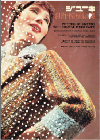 An illustration of the card use
An illustration of the card use  If using thicker yarns on a standard machine that grinds at the loosest tension, this configuration can retain the full design while knitting every other needle/EON.
If using thicker yarns on a standard machine that grinds at the loosest tension, this configuration can retain the full design while knitting every other needle/EON.
The adaptation began using Mac Numbers, the repeat was isolated and traced, and the 12 blank columns were then hidden 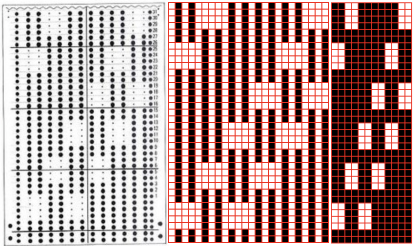 producing a result scaled in indexed B/W mode to 12X36 pixels. The tiled design, checking alignments.
producing a result scaled in indexed B/W mode to 12X36 pixels. The tiled design, checking alignments. ![]()
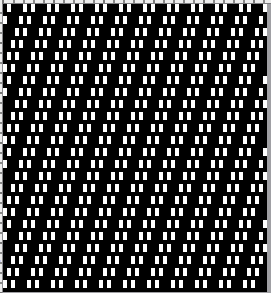 The proof of concept
The proof of concept  Periodically tuck stitch designs that appear to break the usual rules for the stitch are discussed.
Periodically tuck stitch designs that appear to break the usual rules for the stitch are discussed.
This design is intended for a push-button machine capable of 24 stitch repeats, uses symbols in the associated chart interpreted to mean tuck loops form for 2 rows and knit along with all other stitches every third row.  The working repeat is made up of 8 pixels in width, and 36 pixels in height.
The working repeat is made up of 8 pixels in width, and 36 pixels in height. 
![]()

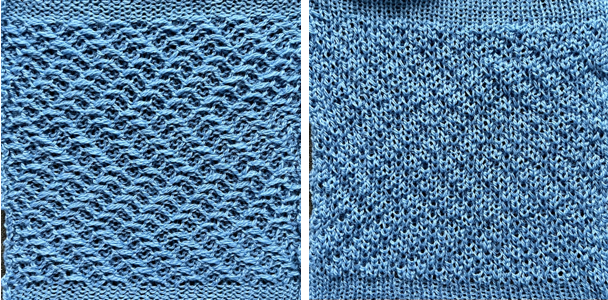 This next design is likely published for use with the Studio color changer, which is marked with letters for each color,
This next design is likely published for use with the Studio color changer, which is marked with letters for each color, 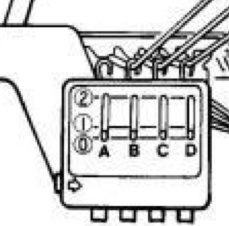 rather than with numbers as in Brother models.
rather than with numbers as in Brother models. 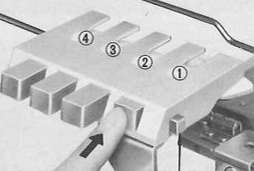
It is intended as a slip-stitch. The bottom swatch relies on color changes every 3 rows, which would need to be performed manually.
In the elongated version, colors are changed using the color changer, every 6 rows. 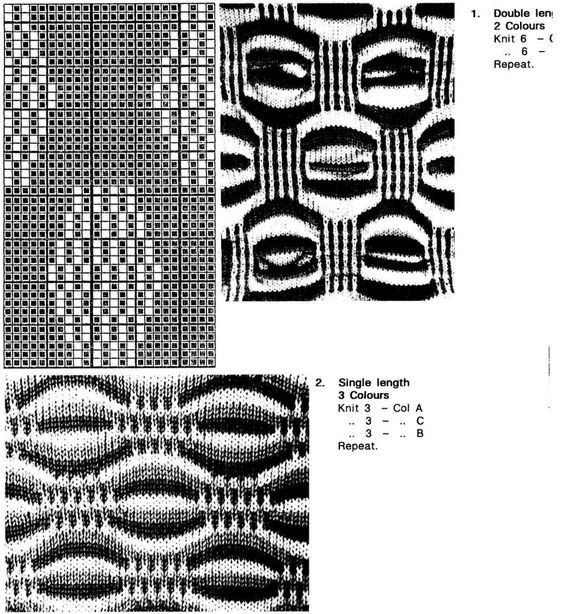 The design was first tested in thin yarns using the electronic 24X84 elongated PNG
The design was first tested in thin yarns using the electronic 24X84 elongated PNG ![]() tested for alignment
tested for alignment 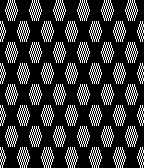 and displays interesting 3D variations, the purl side is remindful of shadow pleating
and displays interesting 3D variations, the purl side is remindful of shadow pleating 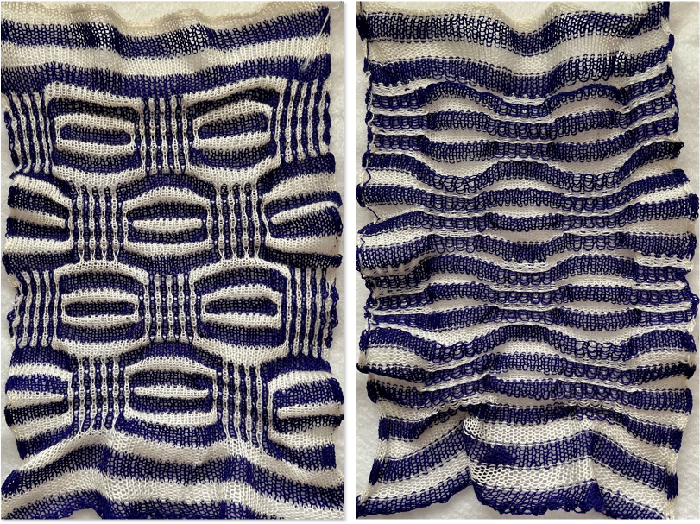 Changing colors every odd number of rows is a tad fiddly.
Changing colors every odd number of rows is a tad fiddly.
The use of the color changer is not an option.
With the three yarns fed through the yarn masts, it became hard to keep them from twisting around each other. Ultimately, that problem was solved by hand-feeding one of the three colors with the cone on the floor, in front of the machine, as one would place yarns for weaving.
Brother knitters are familiar with yarn placements in the sinker plate.
Position A is for knitting when using only one color or for the ground color in fair isle patterning. There is a “gate”, which is closed, and the B color/contrast motif color is placed in that front position, knitting the yarn in needles preselected to needle position D on the next carriage pass.
It is tempting to leave the gate open when switching colors by hand frequently, and that may work for a while, providing tension is placed on the yarn manually to keep the yarn back. If at any point the yarn shifts forward (green arrow), with no needles in position D, stitches will be dropped.
Textured stitches can make for more complicated correction of errors or dropped stitches.
Taking the extra seconds to close the gate (red markings) after each color change avoids what became fondly known as “dropitis” in my classes. 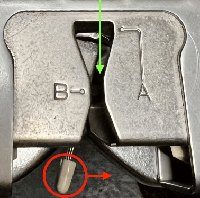 The proof of concept: two of the yarns used were acrylic, so steaming to reduce the curling of the swatch flattened the texture.
The proof of concept: two of the yarns used were acrylic, so steaming to reduce the curling of the swatch flattened the texture.  At one point Studio published a newsletter with cover art composed of simple drawings, such as this, for #143, which spiked my curiosity,
At one point Studio published a newsletter with cover art composed of simple drawings, such as this, for #143, which spiked my curiosity,  and led to these explorations:
and led to these explorations:
the pattern and symbols refer to tuck stitch, but technically the design is executed using short rows and transfer techniques.
The programmed repeat selects needles, making tracking actions easier.
End needle selection is canceled.
No cam buttons are in use.
The knit carriage is set to hold.
Stitches on the single needles selected on rows, 2, 12, 22, etc, are transferred onto the needle on their left. The empty needle is then pushed back to A position, out of work, creating a ladder.
The groups of 3 preselected needles are pushed out to hold, the D position, before continuing.
After every 2 rows knit, a stitch on the left is pushed back into work, until lastly, the empty needle is returned to the B position.
All needles will then knit for one row filling in the empty needle with a loop and a full knit stitch on the next pass where transfers begin again. 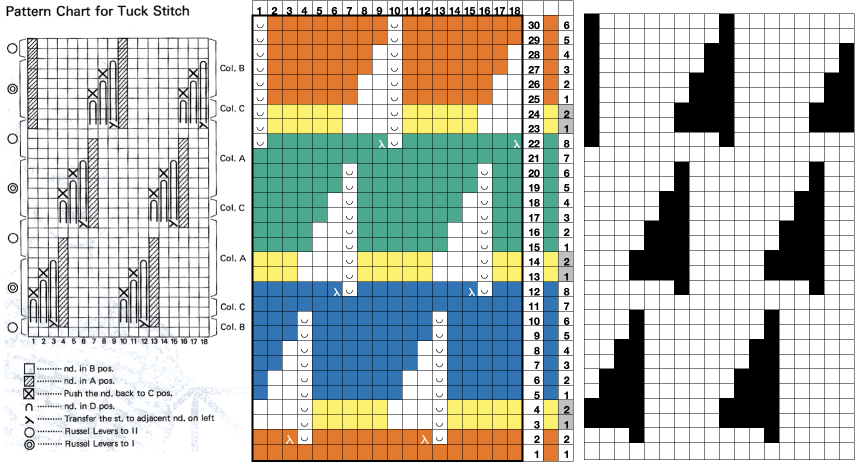 A brief summary of stitch manipulations
A brief summary of stitch manipulations 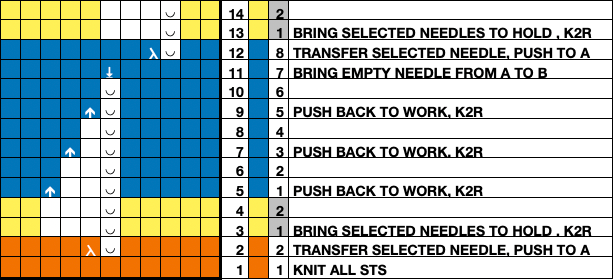 Images of the work in progress, a small claw weight single claw hung on edge stitch helps keep side edges equal in length:
Images of the work in progress, a small claw weight single claw hung on edge stitch helps keep side edges equal in length:
preselected needles initially manually brought to hold position after the first carriage pass to the right
 after the second carriage pass to the left, with the first needle on the left in each group pushed back into work
after the second carriage pass to the left, with the first needle on the left in each group pushed back into work  the second needle on the left in each group is returned to work
the second needle on the left in each group is returned to work
 one needle in each group remaining in hold pushed back into work
one needle in each group remaining in hold pushed back into work  at this point the empty needles have been brought to the B position,
at this point the empty needles have been brought to the B position,  single preselected needles have been transferred to the left, and a pass is made forming loops on the empty needles/ eyelets
single preselected needles have been transferred to the left, and a pass is made forming loops on the empty needles/ eyelets  The original 18X30 repeat, some machine models and download software may require that it be mirrored horizontally,
The original 18X30 repeat, some machine models and download software may require that it be mirrored horizontally, ![]() repeated to 44X30 with a planned distribution of plain stitches at sides, knit in 2/18 wool blends:
repeated to 44X30 with a planned distribution of plain stitches at sides, knit in 2/18 wool blends: 
![]()
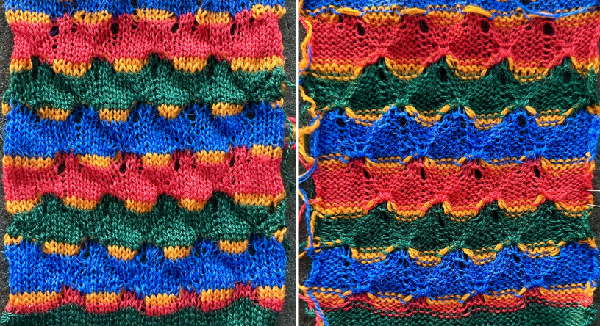 Converting random transfer lace designs poses different challenges, and since the time at which the reference post was published, there have been several Gimp updates.
Converting random transfer lace designs poses different challenges, and since the time at which the reference post was published, there have been several Gimp updates.
Lace designs contain few black and white pixels and, at times are brand-specific. Multiple transfer lace in Studio models begins with 2 blank rows, while Brother begins with a design row, and ends with 2 blank rows. As given, the inspiration repeat is designed for Studio/Silver Reed.
When using any program, ie Gimp, ArahPaint, or even Dak, the original scanned or screengrabbed design needs to be aligned horizontally and vertically to window borders for accurate conversions.
Gimp:
Before any scaling of images, establish stitch and row counts. In this case, they are published as being 16 stitches X 96 rows.
The process for converting the same lace design using Gimp 2.10.34 on the Mac, beginning work in RGB mode:
1. drawing a straight line to the side of the cropped image reveals a slight lean to the right
2. using Image, Transform, and Arbitrary Rotation -0.30 improves the alignment  3. using the rectangle tool, crop to the borders of the published image.
3. using the rectangle tool, crop to the borders of the published image.
In this instance, the cropped image measuring 199X938 pixels is at first scaled to multiples of 10 for both width and height, note the broken chain link
4. 160X960 pixels. 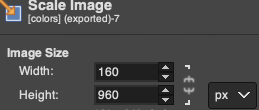 5. Image mode is changed to B/W indexed, and the image is scaled once more to 16X96, the size of the expected repeat, note the intact chain link
5. Image mode is changed to B/W indexed, and the image is scaled once more to 16X96, the size of the expected repeat, note the intact chain link  6. the final repeat, when studied, matches that from the results in the previous post
6. the final repeat, when studied, matches that from the results in the previous post 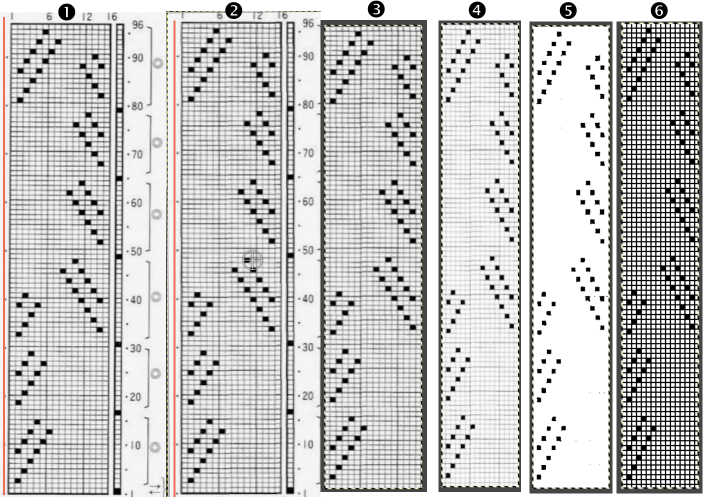 1: the result using ArahPaints tools, including its guess weave from grid, compared to
1: the result using ArahPaints tools, including its guess weave from grid, compared to
2: the Gimp final image and
3. borrowed from the previous post illustrating other considerations before actual knitting, 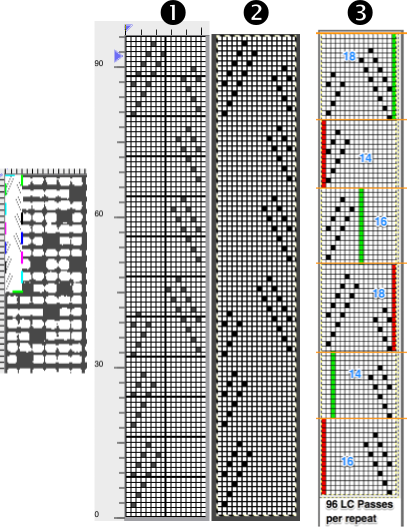
which include:
if using the repeat on Brother machines, the first 2 blank rows of the design are shifted to the top.
The 16-stitch design width makes it suitable only for electronic models.
The final PNG is actually downloaded as a fair isle pattern while maintaining the required needle selection for lace, and the knit carriage remains set to knit throughout while the lace carriage selects and transfers.
The machine, depending on the model, may by default mirror the result vertically, so the final PNG can be mirrored and saved as here, prior to knitting on the 930, ![]() or the mirror function in the machine may be used after programming.
or the mirror function in the machine may be used after programming.
I prefer to save my files in the orientation required for the actual knitting as a means to avoid confusion or errors.
Working in Arahpaint, rotating an image turns it on its center point. To rotate a layer, selection, or image, from the Image menu, choose Rotate.  Selections can be made at offered angles, or specified degrees can be entered in the degree field, or select an area, move the pointer outside the bounding border, and then drag on any one of the small boxes at each corner while pressing the left mouse button.
Selections can be made at offered angles, or specified degrees can be entered in the degree field, or select an area, move the pointer outside the bounding border, and then drag on any one of the small boxes at each corner while pressing the left mouse button. 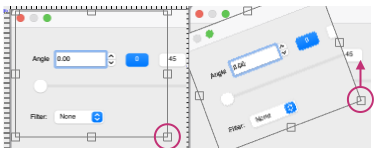 To align the image,
To align the image,
1. load the lace inspiration
2. choose Image, select Rotate Image, and draw a line that follows the orientation of the image. The color will be based automatically on the palette being used, and altering the pencil pixel size or color has no effect.
The program then rotates the image and will inform you of the rotation angle, and the drawn line becomes straight.
To confirm alignment, click the OK or Close button in the Rotate Image window.
3. use the rectangle tool to select the content for the full design repeat, and crop the aligned image to the selection.  4.-9. continue with the steps using the tool Guess Weave from Grid, producing the same final PNG. In summary, they are:
4.-9. continue with the steps using the tool Guess Weave from Grid, producing the same final PNG. In summary, they are:
4. crop the selected image to size
5. change the color palette to 8-bit, adjust background and foreground colors
6. reduce the number of colors to B/W, adjust the threshold, and set the number of colors to 2
7. the resulting image
8. use the guess weave from the grid tool, crop the bounded image to the selection, magnify the results to visually check the repeat, and save the PNG if satisfied
9. the final 16X96 pattern design repeat, matching the Gimp result. 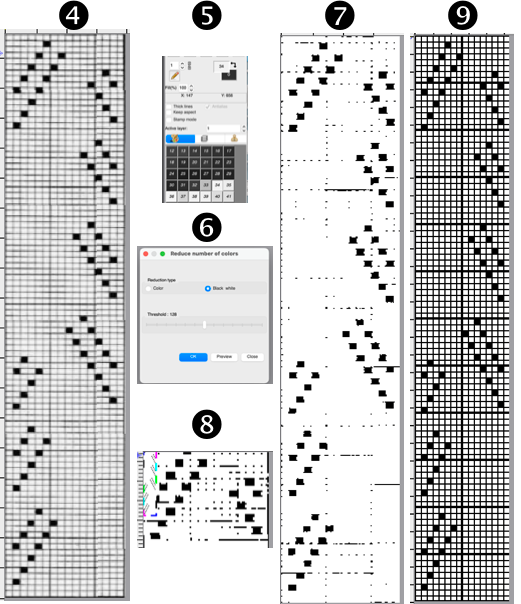 The associated swatch
The associated swatch  This Pinterest find is credited to Tatiana Demina, and is intended for use on Studio punchcard machine models.
This Pinterest find is credited to Tatiana Demina, and is intended for use on Studio punchcard machine models.  Studio machines are capable of transferring and knitting in single carriage passes. Studying the image of the card, it can be seen that there are no blank rows anywhere, and punched holes on alternate rows indicate transfers alternating first to the left, and then to the right.
Studio machines are capable of transferring and knitting in single carriage passes. Studying the image of the card, it can be seen that there are no blank rows anywhere, and punched holes on alternate rows indicate transfers alternating first to the left, and then to the right.
The swatch was knit using the same technique described recently in the post Unconventional uses for punchcards 2: thread lace cards for “filet” mesh
The original 24X56 design 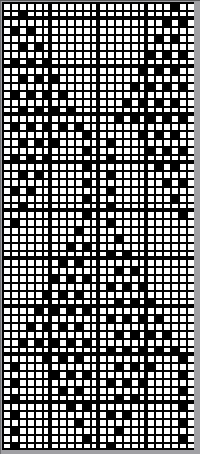
![]() was lengthened X2 to, shown here also doubled in width to 48X112
was lengthened X2 to, shown here also doubled in width to 48X112 ![]() to match the direction of the transfers, the hint offered in the inspiration source can be followed down to indicate the first row of transfers need to be made to the right,
to match the direction of the transfers, the hint offered in the inspiration source can be followed down to indicate the first row of transfers need to be made to the right,  hence the knitting begins with the knit carriage on the left, the lace carriage on the right. As the LC moves to the left it preselects needles, and as it returns to the right it transfers them to the right.
hence the knitting begins with the knit carriage on the left, the lace carriage on the right. As the LC moves to the left it preselects needles, and as it returns to the right it transfers them to the right.
The LC is removed from the knit bed.
The KC knits a single pass to the right and remains there.
The LC is returned to the knit bed on the left, preselects needles on its pass to the right, and transfers them to the left as it returns to that side, and is removed from the bed.
The KC knits one row to the left and stays there.
The LC is returned to the bed on the right and the process is repeated.
Preselection of needles is made by the LC toward the knit carriage, transfers are made away from it.
Whether the repeat needs to be mirrored again may depend on the machine model or the software used to download the file to it.
The direction of the first row of transfers provides the necessary clue, they need to be to the right. If to the left, mirror the pattern horizontally and begin again.
The swatch was knit in a wool-rayon blend, the results point to the difference in appearance and gauge with a change in color and type of yarn used when compared to the inspiration image  The context for this can be found in To mesh or not to mesh 8: more Numbers meet Gimp
The context for this can be found in To mesh or not to mesh 8: more Numbers meet Gimp
 the 60X74 png
the 60X74 png  and the proof of concept
and the proof of concept 
Category: Slip Stitches
Long stitch Passap and Brother DBJ design using thick and thin yarns
In browsing through old photos I came across one of this swatch knit on the Passap eons ago, in a slightly textured unknown fiber, and a thin white one on a small cone with lost fiber markings.  The find led me to attempt a similar knit using my 930.
The find led me to attempt a similar knit using my 930.
The flower image # 1228, 20X20  doubled in height and width to 40X40
doubled in height and width to 40X40
![]() the brick repeat followed by its smallest unit, 20X40
the brick repeat followed by its smallest unit, 20X40![]()
![]() 60X60 half drop, followed by its smallest unit, 40X20
60X60 half drop, followed by its smallest unit, 40X20
![]() To knit the repeats as DBJ to reduce elongation, in the Passap, use Tech 179 intended for single bed fair isle but bring the back bed needles into work to match the Japanese built-in KRC separation along with birdseye backing.
To knit the repeats as DBJ to reduce elongation, in the Passap, use Tech 179 intended for single bed fair isle but bring the back bed needles into work to match the Japanese built-in KRC separation along with birdseye backing.
The built-in double bed fair-isle techniques on the Passap use a default color separation where each color in each design row knits twice.
The console performs the separation, but to achieve the same result in Brother models, the manual color separation can be performed using Gimp in this instance.
A: the chosen file, 20X20![]() B: scaled in length X2, to 20X40
B: scaled in length X2, to 20X40 ![]() C: color inverting every other row beginning with an all-white pixel row
C: color inverting every other row beginning with an all-white pixel row
![]() D: scaling the file X2 in length to 20X80
D: scaling the file X2 in length to 20X80![]() choosing a black row start planned in the background color by color inverting the png
choosing a black row start planned in the background color by color inverting the png ![]() E: taking into consideration that the planned DBJ settings will elongate the design, the 20X80 file is scaled in width X2 to 40X80
E: taking into consideration that the planned DBJ settings will elongate the design, the 20X80 file is scaled in width X2 to 40X80 ![]()
 2024:
2024:
Using color to alpha and opening a series of new files to achieve the same result:  open the 20X40 image
open the 20X40 image ![]() a new file, using a row of white followed by one of an added color from the available palette, ie red in this is 20X2 PNG
a new file, using a row of white followed by one of an added color from the available palette, ie red in this is 20X2 PNG![]() copy it to clipboard and use it to fill a new 20X40 file, white color to alpha
copy it to clipboard and use it to fill a new 20X40 file, white color to alpha ![]() copy and paste it on a new file matching the original
copy and paste it on a new file matching the original ![]() use color to alpha to render the red transparent, then color invert
use color to alpha to render the red transparent, then color invert ![]() paste the result on the original file
paste the result on the original file ![]() scale to double width and height to 40X80, change mode to indexed BW
scale to double width and height to 40X80, change mode to indexed BW ![]() Knitting the swatch:
Knitting the swatch:
The thin white yarn simply refused to be knitted on the 930 without breaking. The problem can sometimes be solved by adding a second thread, which in this case, is a 3,000-yard monofilament serger thread, both are hard to see and slippery.
The way the yarn is picked up and carried varies with the knitting machine models’ color changers.
When using the Brother double bed color changer, it is picked up and swapped out in the ribber arm, 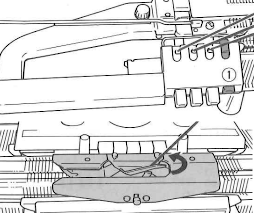 while in Passap models, the colors are threaded into individual feeding eyelets which are swapped out in any sequence needed in the front lock.
while in Passap models, the colors are threaded into individual feeding eyelets which are swapped out in any sequence needed in the front lock.  Some of the yarn-feeding issues in small or large cones can be solved by “putting a sock” on the cones, no matter their size. The manufacturer sometimes supplies the latter, but DIY versions can be segments of pantyhose, foam sleeves used to protect some of the exotic fruits in supermarkets, covers for flowers until they are used in arrangements, and at times simply a plastic bag.
Some of the yarn-feeding issues in small or large cones can be solved by “putting a sock” on the cones, no matter their size. The manufacturer sometimes supplies the latter, but DIY versions can be segments of pantyhose, foam sleeves used to protect some of the exotic fruits in supermarkets, covers for flowers until they are used in arrangements, and at times simply a plastic bag.
My arrangement, with the threads on top of the machine table, and fed through the same side of the yarn mast. 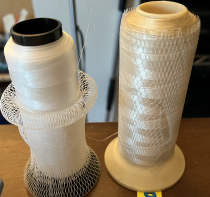 The first preselection row is from right to left
The first preselection row is from right to left
The ribber is set to knit in both directions throughout
The first and last needles are in work on the ribber
Colors are changed every two rows
The backing will be striped, with each color knitting for 2 rows, referred to as striper backing in many pubs.
Pattern knitting begins COL, set the knit carriage to slip in both directions
The proof of concept:  The matching technique using the settings for knitting (N) on the back lock and slip (LX) on the front lock, for striper backing is 183:
The matching technique using the settings for knitting (N) on the back lock and slip (LX) on the front lock, for striper backing is 183:  knit on 30 stitches, but less than full repeat in height.
knit on 30 stitches, but less than full repeat in height.
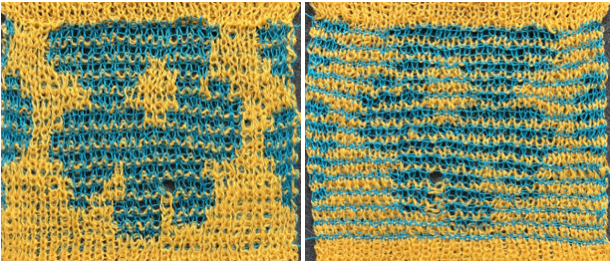 With some understanding of the pattern selection method for the front lock, different Technique numbers may be used for the same knit result simply by changing pusher arrangements and lock settings on either or even both beds.
With some understanding of the pattern selection method for the front lock, different Technique numbers may be used for the same knit result simply by changing pusher arrangements and lock settings on either or even both beds.
This test was knit on 30 stitches and for 100 rows after changing the ground yarn, adjusting the tension, and programming Tech 180, but disregarding the pusher set up for the back bed, and setting the back lock to N 
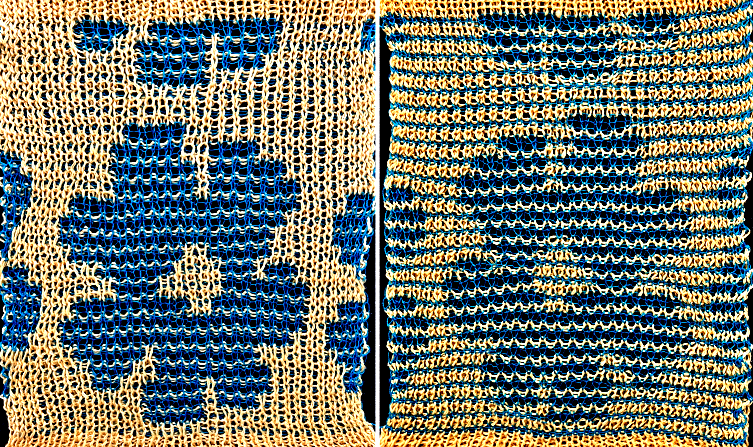 The fabric is stable and reversible with interesting peek-through that reminded me of drop stitch lace.
The fabric is stable and reversible with interesting peek-through that reminded me of drop stitch lace.
The existing color separation for the single-flower ![]() may be drawn in half drop or brick repeats using ArahPaint
may be drawn in half drop or brick repeats using ArahPaint
brick repeat, 40X160![]()
 half drop repeat, 80X80
half drop repeat, 80X80 
 Proof of concept swatch: the knit pattern area measures 14.5X11 inches, was worked on 80 stitches for 160 rows. The design repeat is 80X80 pixels. The fabric is reversible and lies flat.
Proof of concept swatch: the knit pattern area measures 14.5X11 inches, was worked on 80 stitches for 160 rows. The design repeat is 80X80 pixels. The fabric is reversible and lies flat. 
Using punchcards (3) or electronics to track small cables in pattern
Previous shares on aids to tracking cable transfers
Using punchcards to track small cables in pattern 1
Using punchcards to track cables and twists in pattern 2
Visualizing knit cables in color 2_ using Numbers and Gimp
Hand knitting patterns are usually depicted with the knit side facing.
If crossings are intended to match them exactly when working on knitting machines, they are made on the purl side, and their direction needs to be mirrored.
The blue dots illustrate hand-knit symbols, and the pink dots the machine-knit companions  I was recently contacted about the possibility of reproducing the swatch on the far right. The image on the left is an actual knit, first tested with cable crossings mirroring each other along vertical columns.
I was recently contacted about the possibility of reproducing the swatch on the far right. The image on the left is an actual knit, first tested with cable crossings mirroring each other along vertical columns.
The inspiration swatch was likely knit on the bulky, twisted every 4 rows, mine on a 4.5 mm machine, twisted every 5 rows.
It is possible to crop, copy, and paste initial photos, as in the center image, to visualize how the process may be altered prior to spending time creating new charts or any actual knitting. 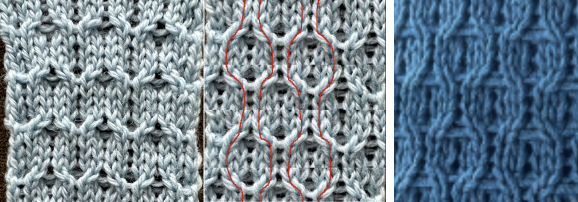 Building charts in a spreadsheet:
Building charts in a spreadsheet:
begin with creating and saving custom shapes, which can be made editable, and outlined if preferred (magenta) to further define the stitch brought forward, with the other moved behind it (blue).
Symbols used:
1. black cells/ knit stitches
2. white cells/ needles out of work, creating ladder spaces and non-selected needle areas where stitches are to be moved in the direction of superimposed arrows
3. red arrows/ stitches that are lifted off the needle bed, brought to the front on the purl side. The stitch on the adjacent black cell/selected needles is removed, travels behind it, and replaces it. The held stitch is then placed on the now-empty needle. Both stitches are brought out to hold/E position to knit properly on the next carriage pass.
The plan is to use the slip-stitch setting in both directions.
Since there are needles not in use, the end needle selection needs to be canceled.
Proper needle placement is required for patterning accuracy.
One option for achieving it is by air knitting the first row of the design, another is to program the width of the planned knit in electronic machines, establishing pairings, and using the single motif setting with no guesswork.
A chain cast-on can be performed, followed by dropping chains in ladder locations and taking those needles out of work to A position.
Even weight is useful if crossings are to begin after only 4 rows of knitting.
Each repeat is 8 stitches wide, punchcard users repeat it X3 in width, and in the charted height X3.  Proofs of concept: 30X20 electronic repeat for vertically mirrored transfers,
Proofs of concept: 30X20 electronic repeat for vertically mirrored transfers, ![]() and the alternating twisted arrangement
and the alternating twisted arrangement ![]() The work on the machine
The work on the machine  In the resulting swatches, patterning errors such as the marked one become difficult to repair after the fact as stitches grow in size and ladders nearly disappear
In the resulting swatches, patterning errors such as the marked one become difficult to repair after the fact as stitches grow in size and ladders nearly disappear 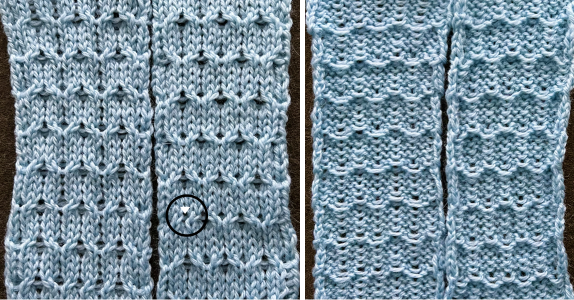 Both swatches measure less than 2.5 inches in width, another reason to explore the results on bulky models if they are to be used in garments.
Both swatches measure less than 2.5 inches in width, another reason to explore the results on bulky models if they are to be used in garments.
If planned as panels combined with stocking stitch, careful planning is due to overall gauge differences and those in row counts when seaming and joining.
Blistered dbj 3
Names referring to the same knit fabric can vary between machine manuals for specific models and brands or references in books, magazines, and articles depending on the dates they were published.
My earlier share on the topic:
Blistered stitches dbj 1
Blistered DBJ 2 and technique variations on a single repeat, introduced some of the concepts involved.
Beginning with any random published repeat can offer the start of exploring a range of fabrics. This was a Pinterest punchcard share, markings indicate it was intended for Brother machines 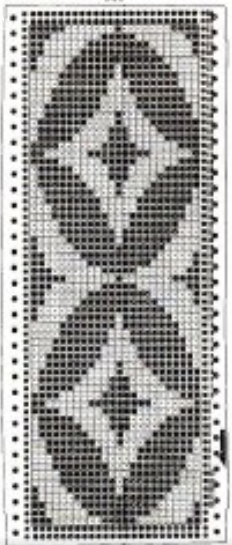 Methods for obtaining color separations for specific knits have been discussed in other posts.
Methods for obtaining color separations for specific knits have been discussed in other posts.
Brother models can use the cam buttons to perform a function in one direction only, ie by using only one tuck or slip button, the machine will knit when the carriage reverses movement to the opposite side.
Developing specific color separations makes the files usable on other machine brands and models, makes it easier to return to specific rows in error corrections, and is my personal preference in test swatching and complete pieces.
Drawing the initial design in repeat provides a visualization of the resulting secondary shapes and the number of needles required for tiled variations in finished pieces based on gauge.
The first design is intended for use in every needle rib, with the knit carriage knitting in one direction, and using slip or even tuck in the opposite direction.
The 24X32 design extracted from the inspiration punchcard 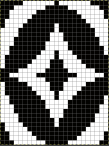
![]() A: the rendering scaling the design twice in length
A: the rendering scaling the design twice in length
B: making the choice to color invert it in planning slipped stitches on the larger number of white pixels
C: superimposing black lines on every other row beginning with row 2 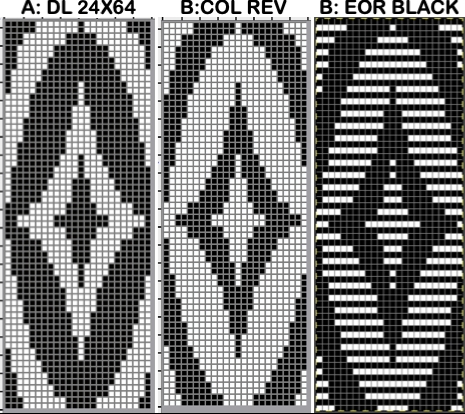 A quick review of the steps involved in working with Gimp:
A quick review of the steps involved in working with Gimp:
begin with magnification for easy viewing, ie. 800X, view grid if preferred
the starting brush can be as small as this 2-pixel ![]() select it and save it to the clipboard by choosing copy visible, making it available to bucket fill images, or export the same design as a .pat file and save it in the appropriate settings folder for future use.
select it and save it to the clipboard by choosing copy visible, making it available to bucket fill images, or export the same design as a .pat file and save it in the appropriate settings folder for future use.  A: the original design repeat rendered in black and white
A: the original design repeat rendered in black and white
B: layer, transparency, color white to alpha
C: file, new, white ground, matching size, filled with a pattern of pairs of horizontal all-white pixel rows beginning with white on row one, followed by all-black pixel rows on row 2
D: copy B and paste it on C, and export the file as png 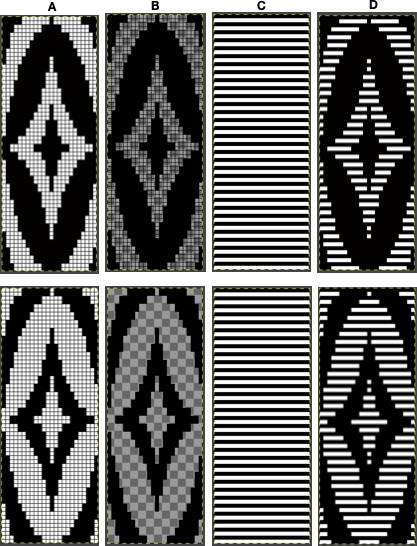 The chosen repeat may not be color reversed after programming it using the machine’s built-in electronic functions.
The chosen repeat may not be color reversed after programming it using the machine’s built-in electronic functions.
White pixels slip, stitches on the main bed in non-selected areas would not knit off for extended periods ie where red marks occur, and noticeable problems would develop quickly  Beginning proofs of concept for this version, 24X64
Beginning proofs of concept for this version, 24X64 ![]() knit on 60 stitches using it drawn in repeat X3, 72X64, and programmed as a single motif
knit on 60 stitches using it drawn in repeat X3, 72X64, and programmed as a single motif  The result is a very subtle contrast lacey knit
The result is a very subtle contrast lacey knit  The yarn thickness and color were changed. The pattern begins using the slip setting and transitions to tuck, also in only one direction. Because the ribber is knitting every stitch between stitches on the top bed holding side-by-side loops down, tucking on multiple side-by-side needles can be performed, producing a wider, stretchy knit that also lies flat.
The yarn thickness and color were changed. The pattern begins using the slip setting and transitions to tuck, also in only one direction. Because the ribber is knitting every stitch between stitches on the top bed holding side-by-side loops down, tucking on multiple side-by-side needles can be performed, producing a wider, stretchy knit that also lies flat.  True blisters/pintucks generally knit rows on the top bed alone forming pockets that are eventually sealed by all knit rows.
True blisters/pintucks generally knit rows on the top bed alone forming pockets that are eventually sealed by all knit rows.
Slip stitch settings are used.
The design is at first lengthened X5, then every 5th row is filled with black pixels or punched holes.
A begins in smaller groups of gathers, testing for any errors or problems, while B allows for deeper folds.  A:
A: ![]() the mark shows the stitches on the top bed begin to slip far too many rows
the mark shows the stitches on the top bed begin to slip far too many rows
due to using the color reverse option in the 930 before continuing to knit. 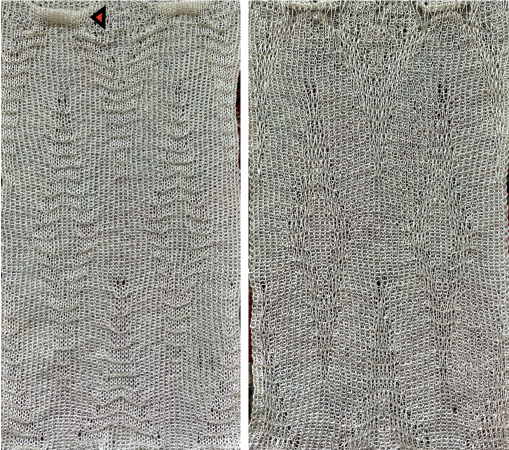 With a switch to the blue yarn, all-knit spaces between the pockets now begin to appear gathered. Slip stitch results in narrower knits, noticeable in the ruffled effects on every needle rib above the cast ons
With a switch to the blue yarn, all-knit spaces between the pockets now begin to appear gathered. Slip stitch results in narrower knits, noticeable in the ruffled effects on every needle rib above the cast ons 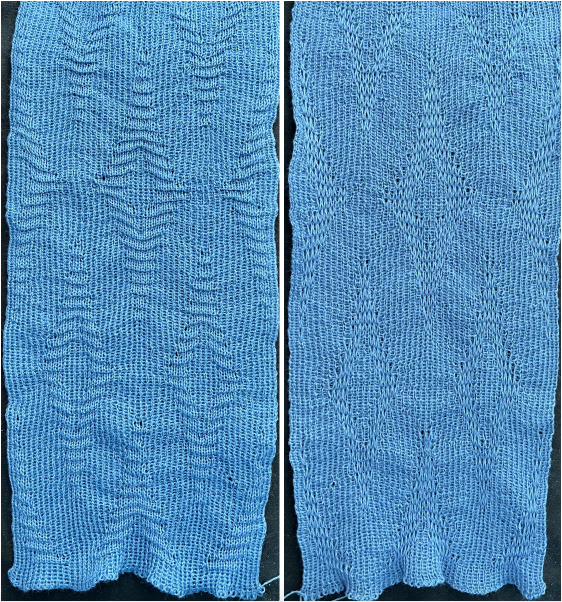 B:
B: ![]() the extra row of slipped stitches result in a far more textured knit
the extra row of slipped stitches result in a far more textured knit 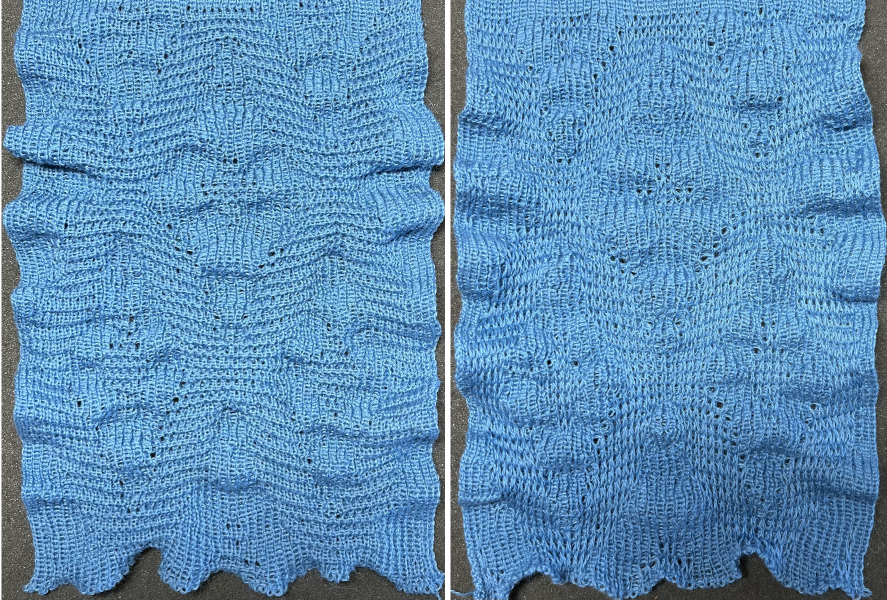 Developing other layouts for the same design, brick 24X128
Developing other layouts for the same design, brick 24X128 ![]()
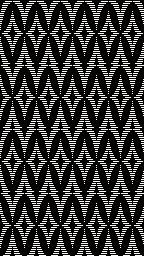 half drop 48X64
half drop 48X64 ![]()
 Eliminating unwanted extra stitches from the original, modified to 24X28 pixels
Eliminating unwanted extra stitches from the original, modified to 24X28 pixels 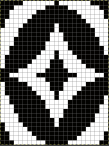
![]() drawn in repeat to 144X168
drawn in repeat to 144X168  brick version 24X56
brick version 24X56 ![]()
 half drop 48X28
half drop 48X28 ![]()
 adding those all knit rows
adding those all knit rows  Viewing repeat alignments
Viewing repeat alignments ![]()
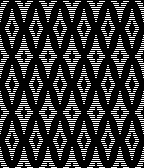 The 24X112 brick repeat suitable for punchcards, not tested,
The 24X112 brick repeat suitable for punchcards, not tested, 
![]()
 and the half drop, 48X56
and the half drop, 48X56 ![]()
 tested using a 10/2 cotton and lightly steamed and pressed. Knit on 80 stitches, it measures 17 inches in width and 11 in height.
tested using a 10/2 cotton and lightly steamed and pressed. Knit on 80 stitches, it measures 17 inches in width and 11 in height.
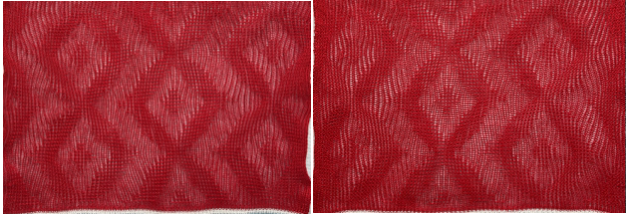 an attempt at a more detailed look
an attempt at a more detailed look 
More slip stitch experiments inspired by commercial designs
PRADA knitwear often becomes a source for inspiration and discussion both in hand and machine-knitting forums. A recent sample:  Developing proofs of concept can begin to be achieved by reducing repeats in size, making sampling quicker to achieve and evaluate.
Developing proofs of concept can begin to be achieved by reducing repeats in size, making sampling quicker to achieve and evaluate.
Larger automated repeats by default require electronic machine programming.
Spreadsheets offer an opportunity to plan color-changing sequences ahead of time and to check their horizontal and vertical alignments.
If a color changer is in use, in the Japanese machine models it sits on the left.
Color changes are made away from and back to the changer as frequently as every 2 rows, or as needed in the specific design.
Other brand machine models have color changers on each side, allowing for single rows knit in any one color and for dividing repeat segments differently.
The assumption here, to begin with, is that each color is carried for an even number of rows.
This chart was developed using Numbers for Mac. The repeat is 40 cells in width, and 52 cells in height, and is outlined with a red border. It is planned so as to return to the initial color selection when completed, maintaining a continuous design, 
![]() tested on 80 stitches.
tested on 80 stitches.  Its alignment is not on a true diagonal, and shapes are offset
Its alignment is not on a true diagonal, and shapes are offset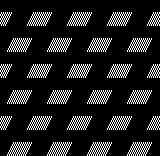 To duplicate the swatch, cast on and knit for a preplanned number of rows with the dark color.
To duplicate the swatch, cast on and knit for a preplanned number of rows with the dark color.
Needle selection serves as a visual guide to the need for color changing in addition to or instead of row counts.
End needle selection is in use, there are no empty needles in this design.
COR: make the first preselection row from right to left, toward the color changer.
COL: remember to set the knit carriage to slip in both directions, pick up the light color
change color every 2 rows until every needle is preselected when moving from the right and back to the color changer (14 rows)
COL: every needle has been pre-selected. During every needle selection, only the dark color is used until preselection changes once more as the knit carriage returns to the left (12 rows)
COL: pick up the light color, resume with color changes every 2 rows (14 rows)
COL: a 12-row sequence with every needle preselection completes the 52-row design.
Repeat the process ending with a preplanned number of rows knit in the dark yarn, and bind off. 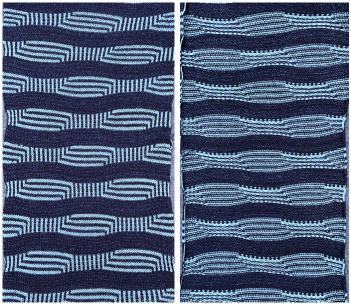 Expanding the design repeat would change the curvature in the solid color stripes.
Expanding the design repeat would change the curvature in the solid color stripes.
This knit is by LAFAYETTE 148, NY.  It is offered with coordinated pieces, which appear to use both a knit and a purl version as the exterior of the knit.
It is offered with coordinated pieces, which appear to use both a knit and a purl version as the exterior of the knit.  Beginning with an electronic slip stitch test emulating the larger shapes in alternating colors, adhering to the limitation of using an even number of rows in each color change, patterning shifts are explored in this 30X24 stitch repeat.
Beginning with an electronic slip stitch test emulating the larger shapes in alternating colors, adhering to the limitation of using an even number of rows in each color change, patterning shifts are explored in this 30X24 stitch repeat. ![]() A tiling test
A tiling test  The extra horizontal lines formed in the swatch are because the goals are
The extra horizontal lines formed in the swatch are because the goals are
1. to make larger shapes in alternating colors with long stitches in the contrasting color in front of them on the knit side,
2. automate the process,
3. and use the color changer.
In each case, the new color needs to be knit first to and from the color changer in order for its stitches to form those elongated stitches in it on the knit side, and knit again after the contrasting color rows to complete each segment of the full repeat.
The visualization chart for the first experiment:
A 30X24 repeat: black cells form knit stitches including below and above white cells. White cells slip until a black cell occurs directly above them.
B a knit side visualization of color changes: the elongated stitches, marked by conical lines, are drawn where they would appear, with floats formed behind them by skipped stitches. 
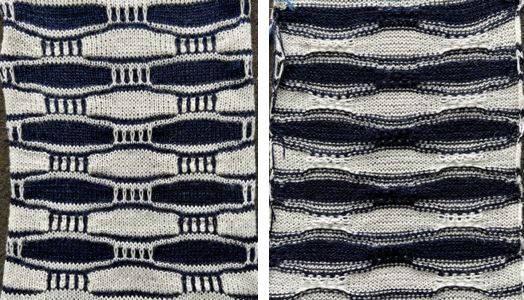 Eliminating extra striping by bringing elongated stitches to the purl side may be achieved by transferring stitches between beds, and using programmed needle preselection to track when to do that.
Eliminating extra striping by bringing elongated stitches to the purl side may be achieved by transferring stitches between beds, and using programmed needle preselection to track when to do that.
Taking the same repeat into consideration, the orange cells serve as markers for stitch transfers  A programmable repeat:
A programmable repeat: 
![]() Cast on for every other needle rib, then transfer all stitches to the top bed. This allows for even weight distribution on all stitches.
Cast on for every other needle rib, then transfer all stitches to the top bed. This allows for even weight distribution on all stitches.
When a closed cast-on does not matter, the “broken toe” cast-on is an alternative to having all stitches on either bed  Using the ribber comb to cast on the single bed is documented in the post
Using the ribber comb to cast on the single bed is documented in the post 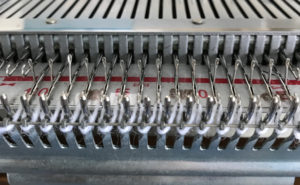 Both the knit and ribber carriages are in use.
Both the knit and ribber carriages are in use. 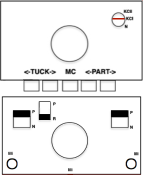 The knit carriage remains set to knit throughout, end needle selection is engaged.
The knit carriage remains set to knit throughout, end needle selection is engaged.
The ribber carriage is set to slip throughout, with needles point to point, its stitches are never knit, they are held until a transfer is made once again.
They stay in the B position after transfers so as not to be knit, are held, and will form the elongated stitches on the purl side, knitting off when the same color is returned to the opposite bed every 8 rows.
After transfers, empty needles are taken completely out of work.
In this visualization, the conical shapes mark areas where the elongated stitches will form on the purl side, R marks stitches transferred down to the ribber, and M, the stitches transferred to the top bed: 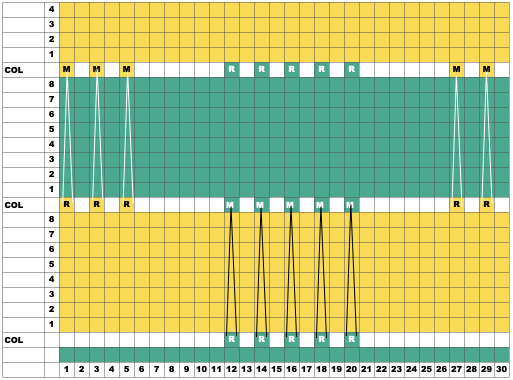 To duplicate my swatch, cast on and knit at least one base row with the dark color, ending COR
To duplicate my swatch, cast on and knit at least one base row with the dark color, ending COR
COR: program the first row, knit 1 row to the left
COL: transfer stitches on preselected needles down to the ribber, and push empty top bed needles out of work, OOW.
 Change to a light color. As the knit carriage moves to and from the color changer, floats will form in the location of the out-of-work needles on the top bed.
Change to a light color. As the knit carriage moves to and from the color changer, floats will form in the location of the out-of-work needles on the top bed.  COR: knit 8 rows, there will be a new preselection as the knit carriage moves to the left
COR: knit 8 rows, there will be a new preselection as the knit carriage moves to the left 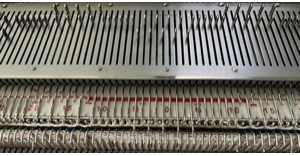 COL: transfer needles previously on the ribber onto the empty needles on the top bed, placing them in work position so they will knit on the next pass, and transfer new needle preselections down to the ribber.
COL: transfer needles previously on the ribber onto the empty needles on the top bed, placing them in work position so they will knit on the next pass, and transfer new needle preselections down to the ribber.  Knit 8 more rows, change to the dark color, repeat transfers of ribber stitches up, preselected stitches down, and continue knitting, following needle prompts.
Knit 8 more rows, change to the dark color, repeat transfers of ribber stitches up, preselected stitches down, and continue knitting, following needle prompts. 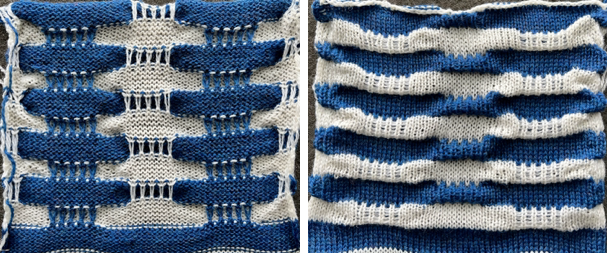 Printing custom needle tapes is an option that relies on printing the generated images to scale.
Printing custom needle tapes is an option that relies on printing the generated images to scale.
Marking the needle tape or metal bed with water-soluble pens or pencils is the old low-tech go-to.
However, custom markings can be made on strips of paper slipped under needles on either bed and marked for any chosen spacing as well as in multiple colors.
An illustration for a test on a repeat different from the programmed one began with marking a strip of paper on the top bed for alternating transfers to and from each bed using two colors:  The resulting tape may be used on either bed, seen here placed on the ribber. The markings on the metal bed are left over from a previous project.
The resulting tape may be used on either bed, seen here placed on the ribber. The markings on the metal bed are left over from a previous project.  The reversed carriage settings
The reversed carriage settings 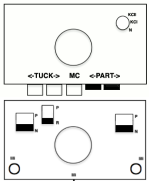 The repeat is not programmed, setting the knit bed to slip allows the knit carriage to make free passes from one side to the other, and the stitches moved to it never knit.
The repeat is not programmed, setting the knit bed to slip allows the knit carriage to make free passes from one side to the other, and the stitches moved to it never knit.
All knitting happens on the ribber.
In Japanese machines, the ribber often produces tighter stitches. Since most needles will be knitting, the tension normally used for the chosen yarn on the top bed for stocking stitch may have to be loosened by one or two numbers for smooth knitting. In Brother machines, the higher the number, the looser the stitch.
The ribber needle presser bar for Brother machines is made of plastic alone and does not exert as much pressure on the needles as the ones used on the single bed, requiring care in watching for needles that slide into other than the proper position during knitting.
is made of plastic alone and does not exert as much pressure on the needles as the ones used on the single bed, requiring care in watching for needles that slide into other than the proper position during knitting.
Emptied needles need to be placed completely out of work.
Floats will form on the ribber as the carriages move across the beds in the location of the empty needles, and the skipped stitches on the opposite bed will grow in length. 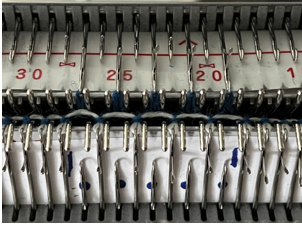 Though the knit side of the fabric is facing the knitter, the long loops appear behind it on the purl side, with the results in the same family as the automated single bed result but with more fiddly execution.
Though the knit side of the fabric is facing the knitter, the long loops appear behind it on the purl side, with the results in the same family as the automated single bed result but with more fiddly execution.  Seeking a closer match for the inspiration companion pieces:
Seeking a closer match for the inspiration companion pieces:
in multicolor slip-stitch patterning, the initial preselection row is generally made toward the color changer, with changes happening from the left and spaced at predetermined even numbers of rows.
Shifting that convention allows for elongated stitches on alternating color shapes without extra horizontal stripes in each color.
The repeat was first visualized and planned in a spreadsheet, repeated twice the necessary width, and outlined with a red border.
A few rows were added at the top of the table, checking for proper alignment of both the design and the color changes. 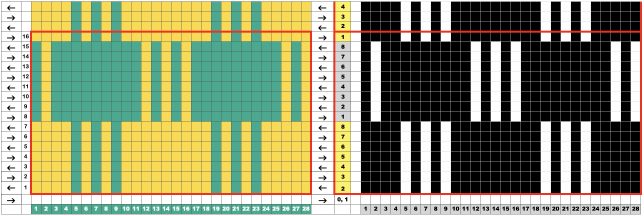 The single repeat measures 14 pixels in width by 16 in height
The single repeat measures 14 pixels in width by 16 in height![]() and was tested on 44 stitches, with a planned knit stitch vertical border on each side.
and was tested on 44 stitches, with a planned knit stitch vertical border on each side. ![]() To duplicate the swatch, cast on using a dark color.
To duplicate the swatch, cast on using a dark color.
COL: the first design row in the adjusted repeat is programmed from left to right, away from the color changer with no yarn in the feeder. Setting the machine to slip in both directions allows the free pass when all needles are in the B position.
COR: thread the light color through the changer’s sinker plate, A position,  and knit to the left
and knit to the left
COL: make certain the light color yarn is properly threaded in its place in the color changer. 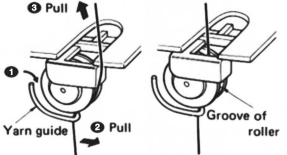 Continue knitting until new needle preselections are made as the carriage returns to the left
Continue knitting until new needle preselections are made as the carriage returns to the left
COL: change to the dark color, subsequent color changes happen every 8 rows. 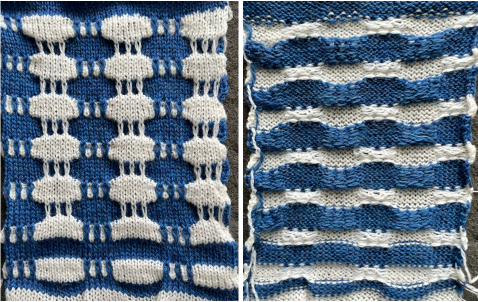
Reviewing a post from 2015 on a slip stitch experiment, the second source image now found attributed to Max Mara, inspired me to try a version using software presently available.  The speed in developing DIY designs and knitting them has grown exponentially with the use of new software and the capacity to move away from mylar sheets or punchcards.
The speed in developing DIY designs and knitting them has grown exponentially with the use of new software and the capacity to move away from mylar sheets or punchcards.
The first 24X56 diamond shape

![]() rendered in half drop, to a 48X112 repeat, with a test in the alignment of multiples
rendered in half drop, to a 48X112 repeat, with a test in the alignment of multiples 
![]()
 The proof of concept was knit at first with color changes every 2 rows, then converted to double length using the machine built-in function, followed by color changes every 4 rows.
The proof of concept was knit at first with color changes every 2 rows, then converted to double length using the machine built-in function, followed by color changes every 4 rows.
The light color yarn is a wool rayon, the dark is a shetland wool.  The all-knit rows on the side edges create ruffles.
The all-knit rows on the side edges create ruffles.
An attempt to show the changes in texture on both surfaces:  The limit on Japanese model machines for tuck stitch unless using very thin yarns is often 4 rows.
The limit on Japanese model machines for tuck stitch unless using very thin yarns is often 4 rows.
The inspiration image appears to have far taller color stripes, slip stitch is far more tolerant than tuck, what about trying color changes every 8 rows?
Keeping in mind that the light color consistently forms the elongated stitches on the purl side with no immediately visible long stitches on the dark color, the repeat first doubled to 48X224, if doubled in length again would require 448 rows of knitting! ![]() A quick partial test revealed the diamond shape is far too elongated and that dark stripe needs to be gathered as well,
A quick partial test revealed the diamond shape is far too elongated and that dark stripe needs to be gathered as well,  Back to the drawing board: after taking a break, the inspiration image is magnified and reexamined, revealing the fact that there are knit and purl stitch combinations across the same rows, not practical to execute on home knitting machines (excluding G carriages from the conversation).
Back to the drawing board: after taking a break, the inspiration image is magnified and reexamined, revealing the fact that there are knit and purl stitch combinations across the same rows, not practical to execute on home knitting machines (excluding G carriages from the conversation).  A compromise, still seeking to elongate only the stitches in the dark color on the knit side of a richly textured knit, planned for color changes every 6 rows,
A compromise, still seeking to elongate only the stitches in the dark color on the knit side of a richly textured knit, planned for color changes every 6 rows,  with color reversal necessary for slip stitch knitting, adjusted in width, the tested 40X162 repeat
with color reversal necessary for slip stitch knitting, adjusted in width, the tested 40X162 repeat ![]() produces a gathered dark color as well. The knit stitches on either side of the shape form ruffles. There were tension adjustments at the bottom of the swatch, increasing the length of the held stitches, the shape is still too elongated for my eye
produces a gathered dark color as well. The knit stitches on either side of the shape form ruffles. There were tension adjustments at the bottom of the swatch, increasing the length of the held stitches, the shape is still too elongated for my eye  An adjusted repeat, the last in the series, 29X168
An adjusted repeat, the last in the series, 29X168![]() tiled to check alignments
tiled to check alignments  and knit on 80 sitch width using this 86 X168 programmed repeat
and knit on 80 sitch width using this 86 X168 programmed repeat 

Blistered DBJ 2 and technique variations on a single repeat
Blistered stitches DBJ began to explore some variations for the production of easy knits which resulted in pockets separated by areas of joined stitches, and depending on the design and whether one bed knits more stitches and rows than the other, can make the surface appear 3D to varying degrees.
There are several things to consider in DIY designs.
In my recent browsing and being inspired by “The curse of truchet tiles”, this png was one of the resulting repeats, developed using ArahPaint. It is larger than any previously tested with this technique.
Beginning with a 36X36 file ![]() drawn in test alignment to 108X108,
drawn in test alignment to 108X108, 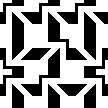 expanding the design through a diagonal choice
expanding the design through a diagonal choice 
![]() into a 72X36 repeat
into a 72X36 repeat ![]()
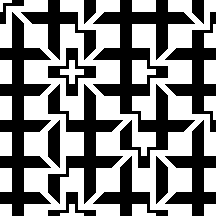 Large repeats require large swatches if gauge matters, but smaller tests serve well to evaluate tension and cam settings. It is a good idea to be consistent in yarn choice.
Large repeats require large swatches if gauge matters, but smaller tests serve well to evaluate tension and cam settings. It is a good idea to be consistent in yarn choice.
Thinking things through:
the white pixel areas will produce the pockets, separating from the ground, and the black pixel areas will compose the joined portions of knit.
To increase the effect, the height of those black pixel areas is reduced by changing their configuration in order to use the slip stitch setting to shorten them.
The first pattern fill requires doubling the height of the whole repeat in order to use the file in a tubular setting. ![]()
 Rather than doubling the file in height, this brush is used to fill the same black pixel areas.
Rather than doubling the file in height, this brush is used to fill the same black pixel areas. 
![]() After a few pixel cleanups, this is the final repeat,
After a few pixel cleanups, this is the final repeat, ![]()
 The png was tiled to the number of stitches planned, with the addition of a knit stitch border along each vertical side
The png was tiled to the number of stitches planned, with the addition of a knit stitch border along each vertical side ![]() and knit on 88 stitches for proof of concept.
and knit on 88 stitches for proof of concept.
End needle selection is on.
The carriages are set to slip in opposite directions, in either arrangement A or B.  In one-color knitting starting preselection side does not matter.
In one-color knitting starting preselection side does not matter.
The tension used, since so many stitches will be knitting on alternate beds, needs to approach that used for the same yarn when knitting stocking stitches.
The red yarn stitches mark the knit side of the fabric.
The cotton ball illustrates the formation of pockets.
The color change happened when the first cone of yarn ran out.
The yarns are 2/28 Italian imports of nonspecified fiber content.
The piece measures 10.5 inches in width.
When the settings are changed from tubular to every needle rib, the fabric is considerably wider and ruffles as seen at the top and bottom of the swatch, which could become a planned design feature.  A segment was cropped from the 72X36 drawn once more in repeat to 84X72, repeating the same steps for processing the file
A segment was cropped from the 72X36 drawn once more in repeat to 84X72, repeating the same steps for processing the file 

 alignment check
alignment check  If the plan is to evaluate the effect of tuck stitch on the design, to begin with, the file needs to be color reversed, whether in the drawn png or using machine settings
If the plan is to evaluate the effect of tuck stitch on the design, to begin with, the file needs to be color reversed, whether in the drawn png or using machine settings  Exploring results with the ribber set to knit in on every row, the swatch below the red line was produced with the knit carriage set to knit in one direction, tuck in the other, while in the remainder the knit carriage set to tuck in both directions. The areas that in slip stitch would form pockets knit in every needle rib, while tuck stitch segments produce a lacy effect.
Exploring results with the ribber set to knit in on every row, the swatch below the red line was produced with the knit carriage set to knit in one direction, tuck in the other, while in the remainder the knit carriage set to tuck in both directions. The areas that in slip stitch would form pockets knit in every needle rib, while tuck stitch segments produce a lacy effect.  The same design, using the png created prior to color reverse, set for tubular slip stitch
The same design, using the png created prior to color reverse, set for tubular slip stitch  the transition between the changes in knit carriage cam settings results in changes in textures and added width
the transition between the changes in knit carriage cam settings results in changes in textures and added width  The full tuck section (bottom) measures 16 inches in width, and the slip-stitch one (top) measures 11.5 inches.
The full tuck section (bottom) measures 16 inches in width, and the slip-stitch one (top) measures 11.5 inches.
Trying for a half-cardigan repeat with the same yarn produced an extremely wide knit with no discernible design.
Tired of double-bed knitting and swatches in a single color and large enough to cover pillows? the starting image reduced in size X4 to 21X18 pixels opens a new series of opportunities for knitting including on the single bed. 
![]() The design, knit here as DBJ, uses the built-in KRC color separation. At the bottom, the knit carriage is set to slip in both directions. The ribber uses the birdseye setting in both directions with the addition of lili buttons.
The design, knit here as DBJ, uses the built-in KRC color separation. At the bottom, the knit carriage is set to slip in both directions. The ribber uses the birdseye setting in both directions with the addition of lili buttons.
At the top, the knit carriage setting remains unchanged, and the ribber is set to knit in both directions, for a striper backing. The tension remained unchanged. The image illustrates the difference in the aspect ratio of the design and the height and width produced by the respective settings. 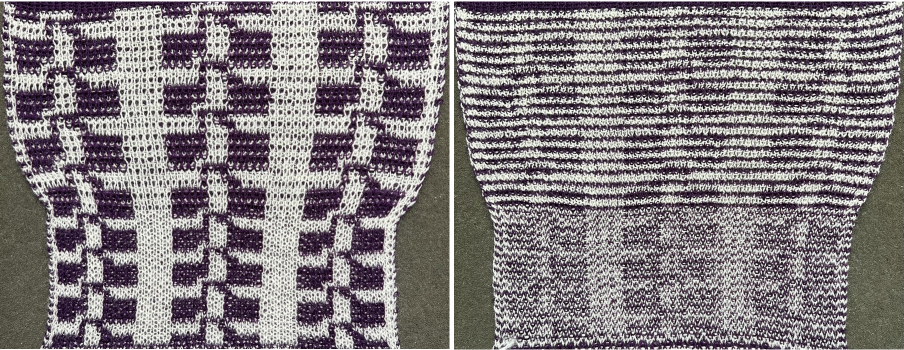 The same design knit as single bed fair isle produces problematic floats on the reverse which would need to be anchored down in a wearable.
The same design knit as single bed fair isle produces problematic floats on the reverse which would need to be anchored down in a wearable. 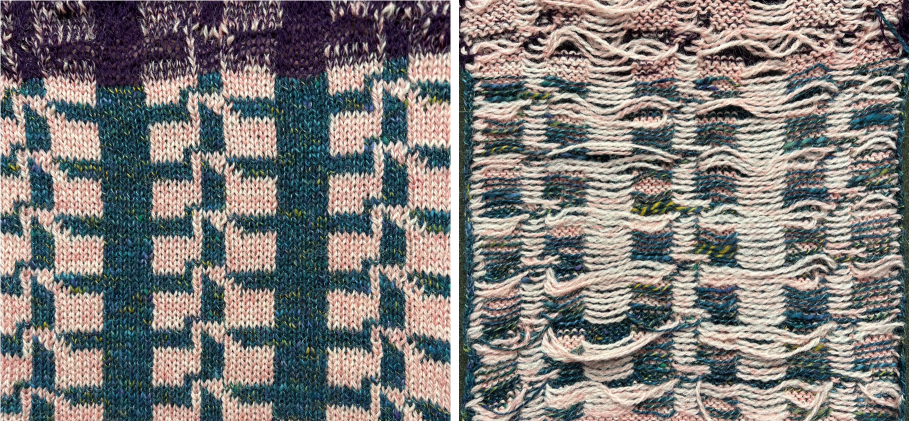 When knitting fair isle end needle selection is used to keep the yarn in the B feeder anchored so as to prevent any separations along the vertical edges of the design.
When knitting fair isle end needle selection is used to keep the yarn in the B feeder anchored so as to prevent any separations along the vertical edges of the design.
Here the light color is 2/8 wool. The yarn in the B feeder is switched to a 2/24 random contrasting color, and the knit carriage is set for thread lace. The white pixels knit both yarns together. Programming a blank row and knitting 2 yarns in this manner is considered by some an alternative to using the plaiting feeder.
End needle selection is canceled. If needles are brought forward, push at least one back to B so the combined yarns knit. In a long piece, a repeat in the width of the planned number of stitches could be planned with one or two blank pixel borders on vertical sides.
Due to the contrast in yarn thickness, the thin yarn creates large stitches that bulge in areas where it knits with the thicker yarn floating behind it, and the areas with combined yarns recede.
The areas in double thickness secure the yarn that produces floats, so that the latter may be trimmed on the purl side, leaving cut ends in any length. When cutting floats, consider sliding something under them and the thin knit so as to avoid cutting it as well, the fabric will release and flatten.  Using elastic, the background yarn used needs to be thinner, here a 2/20. The repeat program is left unchanged, but the position of the yarns is swapped so the elastic/ “thin” is placed in feeder A and the white/ “thick” in feeder B. There is a considerable change in size, observable at the top of the previous images.
Using elastic, the background yarn used needs to be thinner, here a 2/20. The repeat program is left unchanged, but the position of the yarns is swapped so the elastic/ “thin” is placed in feeder A and the white/ “thick” in feeder B. There is a considerable change in size, observable at the top of the previous images.  Aiming for float control, the repeat is edited.
Aiming for float control, the repeat is edited. 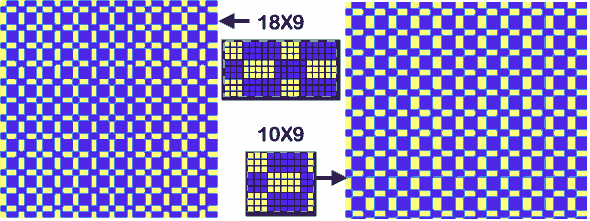 A test of the 18X9 repeat using the fair isle setting measures 6.5 inches in width,
A test of the 18X9 repeat using the fair isle setting measures 6.5 inches in width,  while the same stitch repeat knit using elastic and the thread lace setting adjustments once more, measures just under 2.5 inches in width
while the same stitch repeat knit using elastic and the thread lace setting adjustments once more, measures just under 2.5 inches in width 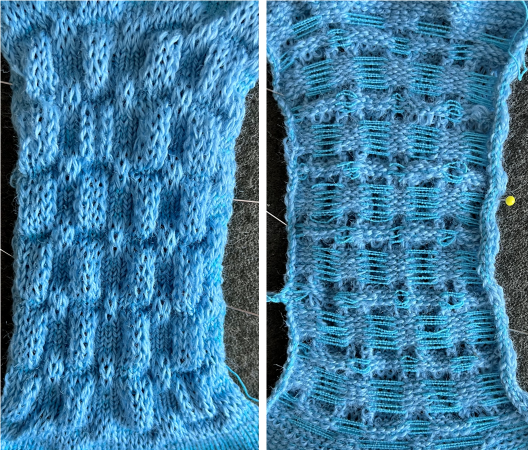
More Truchet inspired tiles, a brief look at gradient filter use
The latest ArahPaint user manual download, updated on February 9, 2023, includes added directions for drawing in repeat including a truchet/Smith tile variant.
This post will not provide specific how-tos, the pngs can be downloaded and used to perhaps test Arah’s features or to aid in finding a personal, preferred method for manipulating DIY designs.
There are additional Arahpaint options for altering designs in width and height which may be used progressively on the same image. Some in the group of edits and rotations are evocative of the Passap console’s Alter programming loop. 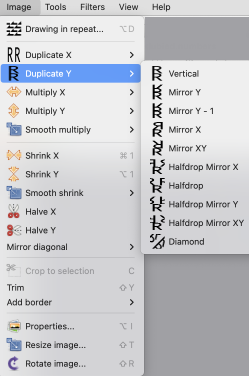 Lower in the same menu, diagonal mirroring opens yet another series of possibilities.
Lower in the same menu, diagonal mirroring opens yet another series of possibilities. 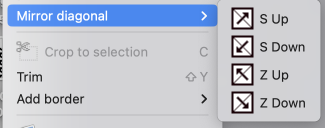 These samples were produced in a Passap workshop, using the console Alter, add commands. Note that mirrored areas have identical pairs of side-by-side pixels at their meeting points,
These samples were produced in a Passap workshop, using the console Alter, add commands. Note that mirrored areas have identical pairs of side-by-side pixels at their meeting points, 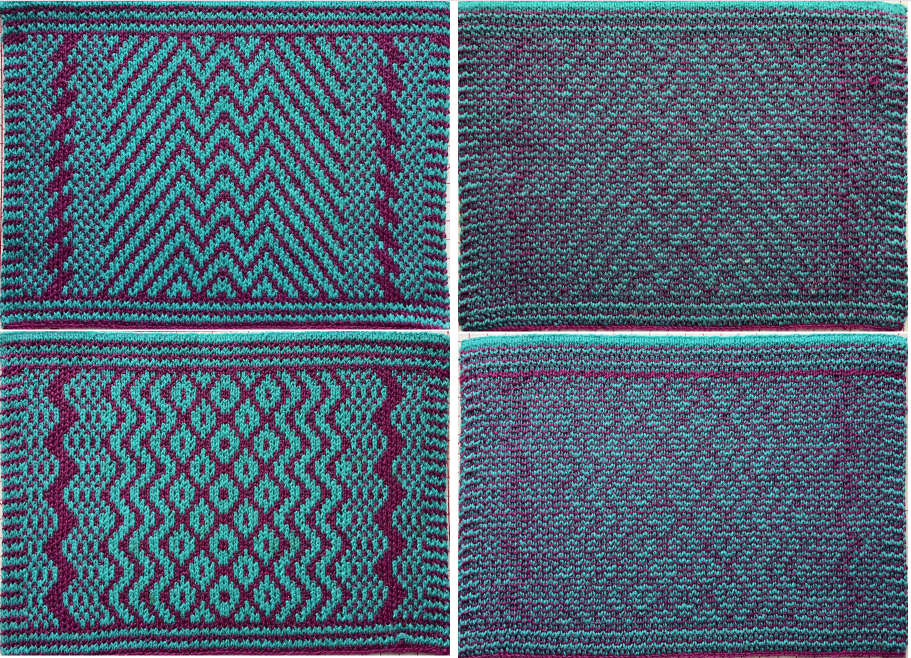 while ArahPaint offers an opportunity to change that, a thing to keep in mind when returning to simpler motifs such as those used for tuck stitch. Performing the rotations, however, will render the result with an odd number of pixels in width, often making them less likely to be usable in punchcard models
while ArahPaint offers an opportunity to change that, a thing to keep in mind when returning to simpler motifs such as those used for tuck stitch. Performing the rotations, however, will render the result with an odd number of pixels in width, often making them less likely to be usable in punchcard models  My area of interest has been primarily and still is in creating textures beginning with small repeats that may grow in complexity and size to make the structures programmable and thus easier to track and execute.
My area of interest has been primarily and still is in creating textures beginning with small repeats that may grow in complexity and size to make the structures programmable and thus easier to track and execute.
Presently I rarely engage in multiple color motif work ie fair isle or other large-scale textile pattern applications but my curiosity in applied techniques has led me down this potential giant rabbit hole.
The speed and ease of drawing variations for repeats using ArahPaint make the process addictive.
The source of inspiration for this design series is “The curse of truchet tiles”.
When recognizable circles are a goal, these tiled motifs often begin with starting sizes as wide as the 24-stitch standard punchcard repeat limitation, and the manipulated larger motifs are suitable only for electronic machine models capable of accepting software downloads. ![]()
![]()
![]()
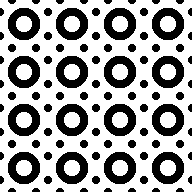 Adding lines and extra dots of circles
Adding lines and extra dots of circles
![]()

 Isolating fractions and individually rotating segments to draw again rendering larger repeats
Isolating fractions and individually rotating segments to draw again rendering larger repeats ![]()
![]()
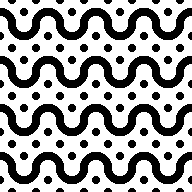
![]()
 More info on knitting DBJ using more than 2 colors per row:
More info on knitting DBJ using more than 2 colors per row:
DBJ: more than 2 colors per row 3 3/22
Img2track_multiple colors per row dbj, each color knitting only once 1/21
DBJ: more than 2 colors per row 2 12/19
DBJ: more than 2 colors per row 1 12/19
Adding one more color to the last repeat whole planning a knitting a test at a max of 3 colors per row knittable in a single track
![]()
![]() The img2track window
The img2track window  Positions of the respective yarns in the color changer as suggested by the program result in accuracy prompts by the machine on which of the respective colors should be in use at any one time.
Positions of the respective yarns in the color changer as suggested by the program result in accuracy prompts by the machine on which of the respective colors should be in use at any one time.  Planning gauge-dependent pieces using large repeats requires large test swatches, generally a minimum of 100 stitches by 100 rows.
Planning gauge-dependent pieces using large repeats requires large test swatches, generally a minimum of 100 stitches by 100 rows.
Adding and varying the colors in the design draft to match the yarns to be used in the repeat helps to visualize the possible result, and allows for using the sequence suggested by the download program to help track the proper color changes.
The test here is 60 stitches wide, knit one full repeat in height, measuring 7.5 inches in width by 11.75 inches in height after resting. On rows where the colors for the dots and squiggles may knit in small parts or not at all, there will be a preselection of large groups of needles such as seen here. 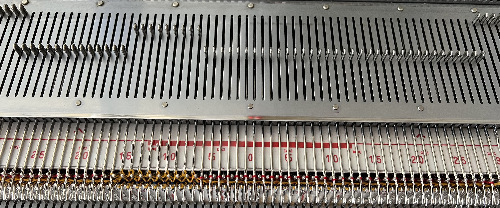 Birdseye setting is used to decrease motif lengthening. The img2track user manual describes the steps necessary for downloading to different model knitting machines and possibly using more than single tracks.
Birdseye setting is used to decrease motif lengthening. The img2track user manual describes the steps necessary for downloading to different model knitting machines and possibly using more than single tracks.  A series inspired by another of the tiles in the linked publication
A series inspired by another of the tiles in the linked publication


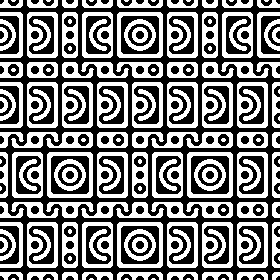
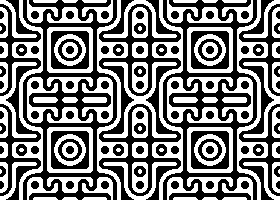 Similar to one of the source repeats, increasing the balance between light and dark
Similar to one of the source repeats, increasing the balance between light and dark 
 Open areas or specific rotations in the visual space may be created by eliminating or rotating individual segments.
Open areas or specific rotations in the visual space may be created by eliminating or rotating individual segments.
To change the mirroring type, place a mouse pointer over the arrow that you want to change, and press the left mouse button. The arrow will jump to the next mirror type. With only 5 mirror types, you will get what you want in a maximum of 4 clicks. If you press the right mouse button, it will put the arrow to the default orientation. 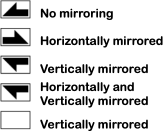 The result of course is dependent on the original file choice.
The result of course is dependent on the original file choice. 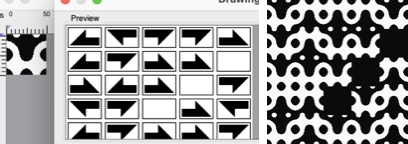 Combining duplicating repeat variations with drawing in repeat helps one develop a DIY library of favored tilings. Begin with a possible background
Combining duplicating repeat variations with drawing in repeat helps one develop a DIY library of favored tilings. Begin with a possible background 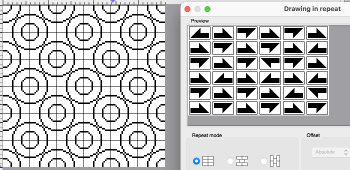
 Tools/ Find Repeat
Tools/ Find Repeat ![]() Aiming for knot variations, a cross-over to add to segments of the ground, manipulating individual tiles, adding copy and paste
Aiming for knot variations, a cross-over to add to segments of the ground, manipulating individual tiles, adding copy and paste ![]()
![]()
![]()




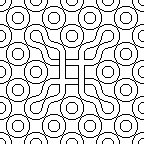 More play with manual duplication of tiles as opposed to drawing in repeat
More play with manual duplication of tiles as opposed to drawing in repeat  Combining different scale repeat segments, starting with 54X36 pixels
Combining different scale repeat segments, starting with 54X36 pixels ![]()

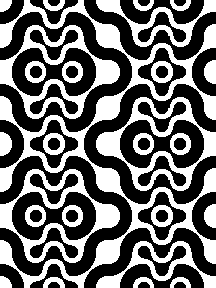 And it’s not all about just circles, a 36X36 pixel design to play with
And it’s not all about just circles, a 36X36 pixel design to play with ![]()
 A reminder, if the plan is to add color in continuous lines, it is best to place the colors after the full design repeat has been developed rather than on the individual starting tile segments, For some, this would be considered a design feature.
A reminder, if the plan is to add color in continuous lines, it is best to place the colors after the full design repeat has been developed rather than on the individual starting tile segments, For some, this would be considered a design feature.  A very different look may be achieved using any of the available filters. A square image of any size may be filled with a color gradient while keeping in mind the fact that knitting is very low resolution and the maximum number of available needles for patterning is 200 or under.
A very different look may be achieved using any of the available filters. A square image of any size may be filled with a color gradient while keeping in mind the fact that knitting is very low resolution and the maximum number of available needles for patterning is 200 or under.
Beginning with a 20-stitch file. ![]() Below the software tool options on the right, click on the tool in the area marked with the red shape
Below the software tool options on the right, click on the tool in the area marked with the red shape  to produce a design that may then in turn be drawn in repeat
to produce a design that may then in turn be drawn in repeat ![]()
![]() No edges were cleaned up in this view. The design meets the maximum 200 pixels/needles size
No edges were cleaned up in this view. The design meets the maximum 200 pixels/needles size 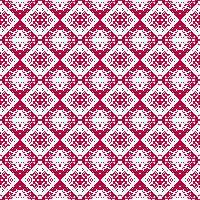 Going larger, an 80-pixel start to end with a 160-pixel blanket or tapestry suitable image with some wiggle room for adding a frame/border.
Going larger, an 80-pixel start to end with a 160-pixel blanket or tapestry suitable image with some wiggle room for adding a frame/border. 

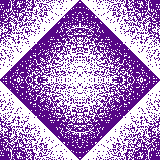
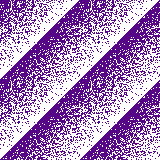
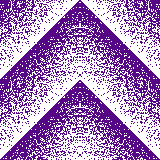 The concept may be used in various densities for use in an accessory such as a scarf,
The concept may be used in various densities for use in an accessory such as a scarf, 
 spaced and colored to your liking,
spaced and colored to your liking, 
 or even sweater bodies and sleeves planned specifically based on stitch and row counts for each of the pieces involved.
or even sweater bodies and sleeves planned specifically based on stitch and row counts for each of the pieces involved. 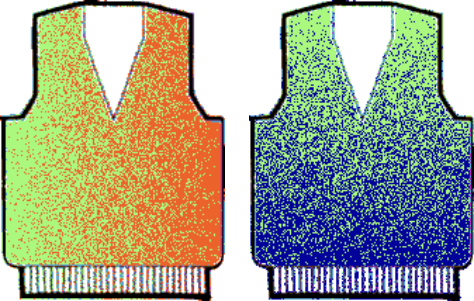 Filters may also be applied in developing other stitch structures in addition to working with color motif designs. That topic merits its own post.
Filters may also be applied in developing other stitch structures in addition to working with color motif designs. That topic merits its own post.
A “fast pattern” user guide shared by the ArahPaint 6 developer October 2023 which demonstrates how to use filters with associated designs https://www.arahne.eu/pdf/fastpattern-EN.pdf
Cross brand pattern interpretations: Dubied to Brother
Reviewing Brother carriages:  I am drawn to published pattern books for different brand machines at different periods of time and enjoy the puzzle of converting their designs to machines I have ready access to.
I am drawn to published pattern books for different brand machines at different periods of time and enjoy the puzzle of converting their designs to machines I have ready access to.
At this point in time most of my swatches are produced on a 930 using img2track to download files when needed while still making an attempt to share repeats usable on punchcard knitting machines when possible.
I have never been in the same space as a Dubied, but have been researching online trying to gather any information that might help me translate more of the patterns presented in the manual “for developing your hand and machine sampling”. These are my personal notes, not meant as accurate teaching tools, but shared to perhaps serve some use to others when decoding cross-brand pattern instructions.
Close to the completion of this post, I acquired the manual for the Dubied N4 model from a friend, with these images and some variations of the text.  The associated tools from an online sale site:
The associated tools from an online sale site:  Manuals available online for free download
Manuals available online for free download
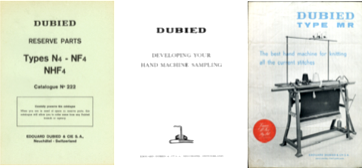 Another source of inspiration for a different machine, Italian text only available, with many similar stitch structures:
Another source of inspiration for a different machine, Italian text only available, with many similar stitch structures: 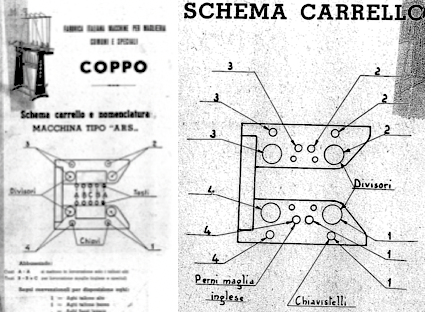 The Coppo numbering for settings in a box format
The Coppo numbering for settings in a box format  My initial attempts to develop an understanding of functions began with an illustration from the Dubied N4 parts manual
My initial attempts to develop an understanding of functions began with an illustration from the Dubied N4 parts manual 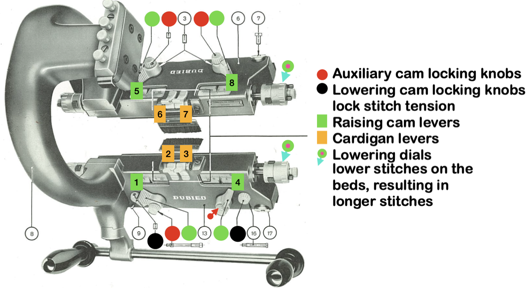 Some related functions, the term cardigan is used to refer to what many of us know as tuck stitch.
Some related functions, the term cardigan is used to refer to what many of us know as tuck stitch.  Visualizations of mirrored matching cam lever positions on opposite beds.
Visualizations of mirrored matching cam lever positions on opposite beds. 
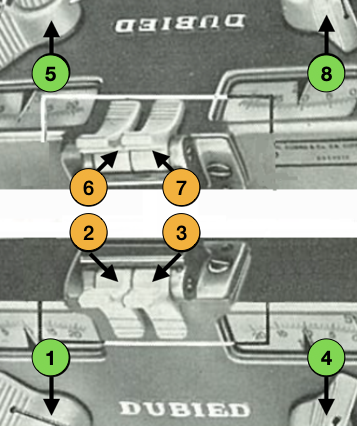
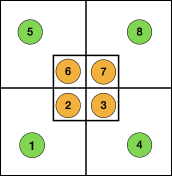 These machines do not create patterns via punchcards, instead, cams inside the carriages are controlled by switches that alter stitch formations. They are classified by the inclusion of the following symbols
These machines do not create patterns via punchcards, instead, cams inside the carriages are controlled by switches that alter stitch formations. They are classified by the inclusion of the following symbols
N: equipped with rib and tube cams
F: equipped with cardigan cams for the execution of all tuck stitch fabrics
H: fitted with high and low butt needles. The raising cams operate either all the needles or high butt needles only. All machines with these needles are equipped with cam-plates allowing all the knit-and-tuck or all-tuck combination fabrics to be formed
4: 4 yarn carriers, which can be placed on either side and allow the manufacture of different pieces at once.
Basic rib structures are modified further by positioning needles in specific needle arrangements.
Functions and settings are often represented in manuals and publications in varied ways. The N4 manual supplement shows an undercarriage numbering system that uses a different sequence than my illustrations. The particular model introduced the addition of auto cams, allowing for alternate function patterning on needles in different positions. 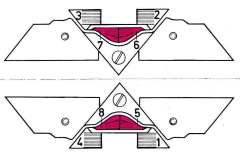

 I find it easier to think of settings on each bed separately, especially in cases where bed instructions also need to be reversed.
I find it easier to think of settings on each bed separately, especially in cases where bed instructions also need to be reversed.
This is my initial effort at illustrating comparisons between the Dubied and Brother settings for knitting specific swatches.
Any fabrics acting on stitches occurring on selective tuck or slip stitches on one or both beds would need to be programmed in Brother machines for patterning on the top bed. On the ribber, the use of lili buttons will automate card 1 needle selection in the pattern on an even number of needles, but in many instances, in executing the Dubied patterns, hand selection in specific needle arrangements may be required as often as every row.  Information from N4 pub after I had created the above, with additions and some paraphrasing: the numbering system for “keys and levers”
Information from N4 pub after I had created the above, with additions and some paraphrasing: the numbering system for “keys and levers” 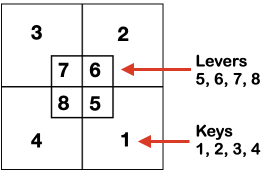 Key positions:
Key positions:
1. closed if turned toward the inside of the carriage, no rows will be knitted ie slip stitch in both directions for a free pass, no knitting, with no yarn using Brother
2. opened if turned toward the outside/ away from the carriage, rows will knit
3. central position for floating threads on the low-heel needles, knit/slip, programming for needle selection in upper work, Brother D, and lower, Brother B, or limited Brother ribber selections using lili buttons
Stitch size dials:
Numbering from 1-20, two on the front carriage, two on the rear carriage, three lengths can be set using the stitch size dial, indicated by three colors red, black, and green  (Cardigan) Levers: each lever can be positioned separately: pointing toward the outside of the carriages/ back: the space between them
(Cardigan) Levers: each lever can be positioned separately: pointing toward the outside of the carriages/ back: the space between them  neutral/middle: if activated will hold the thread on all needles (tuck loops across all needles in work)
neutral/middle: if activated will hold the thread on all needles (tuck loops across all needles in work) pointing toward the inside of the carriage/ forward: if activated will hold the thread (form tuck loops) on the low heel (non-selected needles in Brother)
pointing toward the inside of the carriage/ forward: if activated will hold the thread (form tuck loops) on the low heel (non-selected needles in Brother) Sliding unladen (no yarn) carriage/ free pass: made with keys 1, 2, 3, 4 closed/ Brother carriages set to slip in the direction of knitting
Sliding unladen (no yarn) carriage/ free pass: made with keys 1, 2, 3, 4 closed/ Brother carriages set to slip in the direction of knitting
Plain knit or any rib setting: Keys 1, 2, 3, and 4 open the carriages work on selected needles, levers facing outward/ Brother with both beds set for plain knitting
Combining knit carriage needle selection with racking 2017 and
A racking tale: Passap/Brother 3 in 2019 used this repeat as the springboard for textures that did not match the original in stitch and row counts or racking sequences. The racking handle position is referred to as up or down, similar to the Passap system.  The ribber is used as the front bed.
The ribber is used as the front bed.
I initially interpreted a round as a single row of knitting and held onto that for a while, and my arrangement for needles in and out of work on either bed was reduced.
Sometimes there are good reasons why our swatches do not match the inspiration one, a bit like changing ingredients in a recipe and wondering why the result is different.
The first test: in practice, I was unable to get the ribber to rack by 4 positions after only 3 knit rows; the problem was solved by changing the needle arrangement and racking by only 3 positions in either direction. Another option would have been to add more all-knit rows between racking sequences, as seen in the subsequent Coppo machine pattern adaptation, creating deeper folds.
The tension was adjusted to the tightest possible and remained fixed without variations on either bed.
The gauge is likely looser than suggested in the Dubied manual, forming larger stitches and resulting in a softer shape definition.
Brother tension adjustments can only be made on one dial on either carriage, while the Dubied offers multiple settings on both beds.
To knit manually changing ribber settings, cast on with racking position on 7.
After casting on and transferring stitches up to the top bed, the needles are arranged as follows: blank cells represent needles placed out of work back to A position:  1. Knit 3 rows on both beds
1. Knit 3 rows on both beds
2. Set the ribber to slip in both directions, knit 3 rows on the top bed only, and rack to position 10
3. Set the ribber to knit, knit 3 rows on both beds
4. Set the ribber to slip in both directions, knit 3 rows on the top bed only, and rack back to position 7.
Repeat the 4 steps, ending with 3 knit rows before binding off.
Elongated stitches happen on the bed with needles out of work, in this case, the ribber, and the texture will appear on the knit side.
The needed racking positions become easy to identify as the knitting begins to grow. If one wishes to track hand techniques along with their respective row numbers and racking positions a spreadsheet can quickly be created including specifics ie in this case row counts, ribber settings changes, and racking positions:  Automating the selection, and swapping beds make the process easier to track: begin on racking position 7, inverting the needle arrangement to keep the same racking sequence. Cancel end needle selection whenever any needles are out of work on the main bed and the knit carriage is set to slip in both directions. It is not always necessary, but a good habit to develop.
Automating the selection, and swapping beds make the process easier to track: begin on racking position 7, inverting the needle arrangement to keep the same racking sequence. Cancel end needle selection whenever any needles are out of work on the main bed and the knit carriage is set to slip in both directions. It is not always necessary, but a good habit to develop.  The width of the main bed is programmed using a repeat that has 3 rows of punched holes/black pixels, followed by 3 unpunched rows/white pixels repeated X2, for a total of 12 rows.
The width of the main bed is programmed using a repeat that has 3 rows of punched holes/black pixels, followed by 3 unpunched rows/white pixels repeated X2, for a total of 12 rows.  Emptied needles on the knit bed are pushed back out of work to the A position. All ribber needles are in the work position.
Emptied needles on the knit bed are pushed back out of work to the A position. All ribber needles are in the work position.
Needle preselection in Brother on the knit bed will not interfere with racking since ribber needles are continuously in the B position.
Cancel end needle selection, KCII, as in any fabric with slip stitch selection on the top bed combined with needles out of work.
After the repeat is programmed and the first preselection row has been made, racking will happen every 6 rows, first to position 10, and then back to 7.
The starting side does not matter unless color changes are intended on every even number of rows.
Elongated stitches happen on the bed with needles out of work, the texture will appear on the reverse side, where all needles are in work (NOOW). The blue is knit with NOOW and with setting changes on the ribber every 3 rows, while the yellow swatch is knit with the main bed programmed with NOOW and a 12-row repeat using the slip stitch setting in both directions.  When a round is interpreted as 2 rows of knitting, the carriages leave and return to the same side, color changes can be considered. The out-of-work/in-work needle arrangements now match the published counts, along with the repeat for knitting with the top bed set to slip and knit rather than the ribber. The method is the same as previously described.
When a round is interpreted as 2 rows of knitting, the carriages leave and return to the same side, color changes can be considered. The out-of-work/in-work needle arrangements now match the published counts, along with the repeat for knitting with the top bed set to slip and knit rather than the ribber. The method is the same as previously described.
Racking is now planned by four positions and occurs every 12 rows once the needles are all preselected on the top bed, starting at racking position 6, to 10, and back to 6, 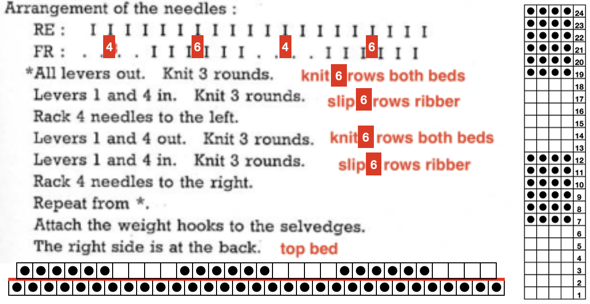 producing a swatch matching the original.
producing a swatch matching the original. 
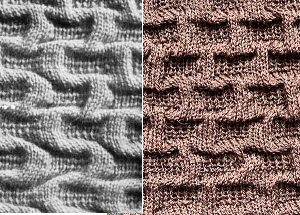 What about adding color changes? An easy place to change color is when the needle selection changes from slip to knit, with each color knitting for 6 rows, remembering to also rack after every 12 rows.
What about adding color changes? An easy place to change color is when the needle selection changes from slip to knit, with each color knitting for 6 rows, remembering to also rack after every 12 rows.
The brown yarn was hard to see clearly on the needle bed. When off the machine there were interesting unplanned areas of dropped stitch lace where dropped stitches on the top bed had been missed.
Tabling the idea of adding other colors to this particular pattern, at least for now, but never say never in knitting (and baking).  And then there is this related pattern in the manual that involves racking by 4 positions and deliberately dropping stitches.
And then there is this related pattern in the manual that involves racking by 4 positions and deliberately dropping stitches.  With some experience, needle setups can be varied to suit, while achieving the same results as published illustrations.
With some experience, needle setups can be varied to suit, while achieving the same results as published illustrations.
I prefer to start with racking to the left, and, as a result, the shapes in my swatches are mirrored horizontally when compared to those in the manual’s photo.
There are ways to make casting-on quick for testing small swatches when permanent edging starts do not matter.
One method to do so was described in the post: Ribber cast on comb/ open stitch single bed cast-on and was used here.
Ribber cast on combs traditionally came in different colors. I tried to use one of my grey ones, presumably a Studio 4.5 mm one, and found the spaces between its teeth not matching that between my Brother machine needles evenly. There were no issues when using the “silver” Brother comb.
Here, it is shown in position, with stitches cast only on the top bed,  followed by picking up loops for stitches on the ribber as the carriages travel to the opposite side.
followed by picking up loops for stitches on the ribber as the carriages travel to the opposite side.  The plan is to move ribber stitches to the left by two positions three times before returning them to their original position.
The plan is to move ribber stitches to the left by two positions three times before returning them to their original position.
The ribber carriage is set manually to knit on dark yarn rows and to slip on light yarn rows.
The ribber setting “song”: light/ slip levers up, dark / slip levers down.
The dark forms the dropped stitch lace pattern; it is thinner than the light color yarn, and the knit steams fairly flat.
Stitches are dropped by disconnecting the ribber carriage and making passes with no yarn, first to drop the stitches and then to couple it once more with the knit carriage to continue knitting.  Automating the pattern, switching beds: program a 12-row repeat for 2 rows slipped, 2 knitted across all needles in work.
Automating the pattern, switching beds: program a 12-row repeat for 2 rows slipped, 2 knitted across all needles in work.
Note to self: when you swap beds and the ribber is forming all the knit stitches, do not use the ribber carriage to drop all the stitches on it!
Both yarns here are thin and steam/press fairly flat.
If a ribber cast-on for every other needle is used, remember to change the pitch from P to H after the transfers between the beds have taken place. A check to confirm that needles will not smash into each other is quick to perform and well worth doing before continuing.
My needle arrangement: 

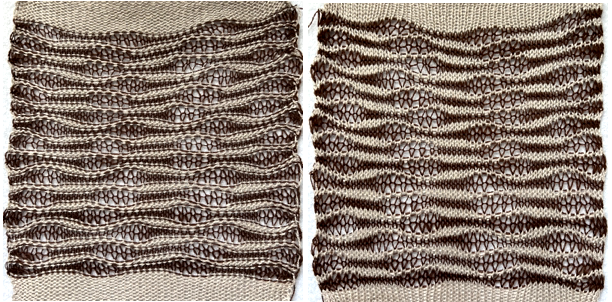
Interestingly, the swatch photographs accompanying directions in the Coppo manual are not “perfect”, some showing pattern adjustments or even sporting holes not part of the design. This texture is very similar to the above
 I initially interpreted 4 rounds as meaning 4 rows of knitting.
I initially interpreted 4 rounds as meaning 4 rows of knitting.
The resulting adaptation: cast-on with the racking indicator on 6. The red numbers illustrate the guide provided in the publication, and the bold black count adjustments in the actual knitting of the pattern. If attempting to match the original, the 6 rows knit on the top bed should actually be 8 prior to racking.
The racking handle is set to 6
1. Knit 4 rows on both beds
2. Knit 4 6 rows on the top bed only
Rack by 4 positions, no direction given, I chose left to 10
3. Knit 4 rows on both beds
4. Knit 4 6 rows on the top bed only
Rack by 4 positions, I chose right to 6
Repeat steps 1-4
The elongated, slipped stitches are formed on the ribber, the bed with needles out of work, and the texture will appear on the knit side.
In any racking, the ribber bed may move beyond the stitches on the knit bed as the carriages move past the needles originally cast on and past the end stitch on one side or the other. This can help create some interesting side edgings.
The first test swatch is knit changing ribber settings from knit to slip. If all needles are in work and the slip stitch setting is used, a float will be formed on the ribber if it has moved beyond the last needles in work on the opposite bed until the yarn reaches the stitches on the main bed as well.
It will not be an issue if the stitches on that side are transferred up to the main bed. 
 Automating the process, the beds are reversed, the repeat is now 20 rows high, and the knit carriage will be set to slip in both directions.
Automating the process, the beds are reversed, the repeat is now 20 rows high, and the knit carriage will be set to slip in both directions.  The needle setup matches the one provided by the manufacturer.
The needle setup matches the one provided by the manufacturer. ![]() Empty needles are pushed back to the A position after transfers.
Empty needles are pushed back to the A position after transfers.
Racking happens every 10 rows, following the every-needle in work preselection on the main bed.  This pattern utilizes the cardigan/tuck function and requires thicker yarn. The wool used here is a 2/8 weight, knit at as tight a tension on the ribber as possible, in this case, 6. Here, the instructions for knitting include references to specific numbers of rows rather than rounds.
This pattern utilizes the cardigan/tuck function and requires thicker yarn. The wool used here is a 2/8 weight, knit at as tight a tension on the ribber as possible, in this case, 6. Here, the instructions for knitting include references to specific numbers of rows rather than rounds. ![]()

 I was unable to reproduce anything like this sample in the manual with the illustrated needle arrangement, revised it.
I was unable to reproduce anything like this sample in the manual with the illustrated needle arrangement, revised it.
 The revised needle arrangement allowed for forming a vertical single-stitch column as in the swatch, and the racked patterns occurred at the center of a purl ground.
The revised needle arrangement allowed for forming a vertical single-stitch column as in the swatch, and the racked patterns occurred at the center of a purl ground.
The swatches are knitted in different wool weights. Racking happened by 2 positions after each round/ pair of knit rows; the starting side did not matter. 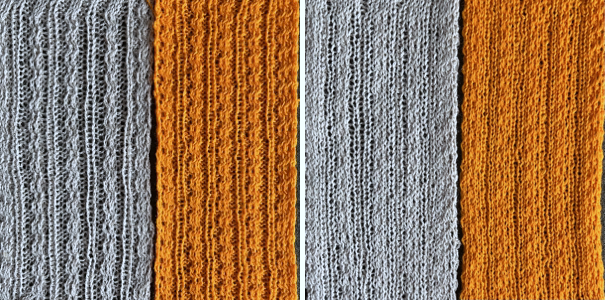 The above were knit using the slip stitch setting.
The above were knit using the slip stitch setting.
Reviewing the manual once more, it was noted that the sample was in the center of a page with the heading: racked fabrics in the cardigan/ tuck stitch. The stitch formations using tuck stitch on alternating Brother and Passap beds are reviewed in the post on Fisherman and English rib.
No specific lever or key instructions were provided. The general advice given to knit the cardigan, aka fisherman’s rib, is to start with the Dubied carriage on the right, all keys open, and push lever 8 (front left) and lever 6 (rear right) to a neutral position (9). In the outward direction, the carriage knits along the rear needle bed and holds the thread on all the needles of the front needle bed; on the return, it alternates the processes, a tubular tuck.
On Brother, it would be done by selecting opposite tuck buttons, making either the selections on the left or on the right. 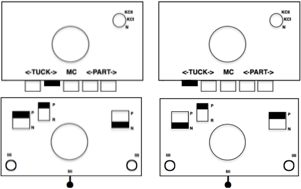 That is simply not happening with the pattern needle arrangement on a Brother machine, there are not enough stitches on opposing beds to anchor down tuck loops.
That is simply not happening with the pattern needle arrangement on a Brother machine, there are not enough stitches on opposing beds to anchor down tuck loops.
Half fisherman, aka English rib, tucks on every needle in work on one pass and knits every needle on the same bed on the return pass.
The new swatch is knitted using the same modified needle arrangement as added to the photo from the manual, starting from the right, with the ribber carriage set to tuck to left, knit to right, and the main bed set to knit every needle. 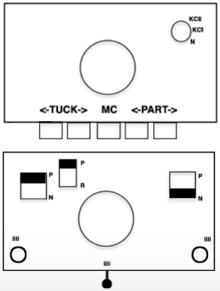 The swatch is shown in progress on the machine with needle placement as it would appear in the starting setup before knitting 2 rows.
The swatch is shown in progress on the machine with needle placement as it would appear in the starting setup before knitting 2 rows.
The first row tucks on ribber needles when traveling to the left, the second knits on them when returning to the right, followed by racking 2 positions to the left.
Two more tuck/knit rows are followed by racking by two positions back to the right, in the starting needle arrangement.


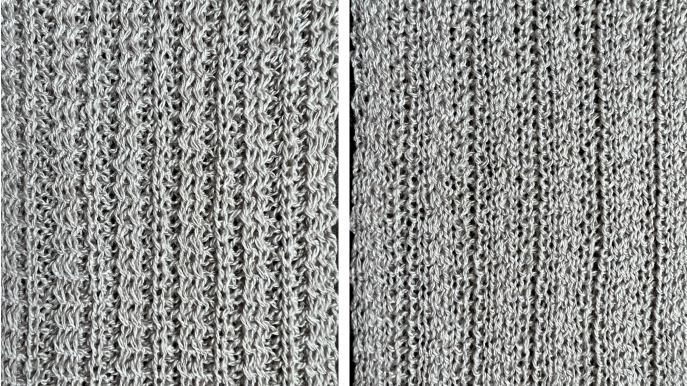 The manual image is shown on the left, and the Brother swatch, mirrored horizontally, is shown on the right.
The manual image is shown on the left, and the Brother swatch, mirrored horizontally, is shown on the right.  I found the following Dubied knit particularly interesting, and it reminded me of this sample knit single bed in a previous post.
I found the following Dubied knit particularly interesting, and it reminded me of this sample knit single bed in a previous post. 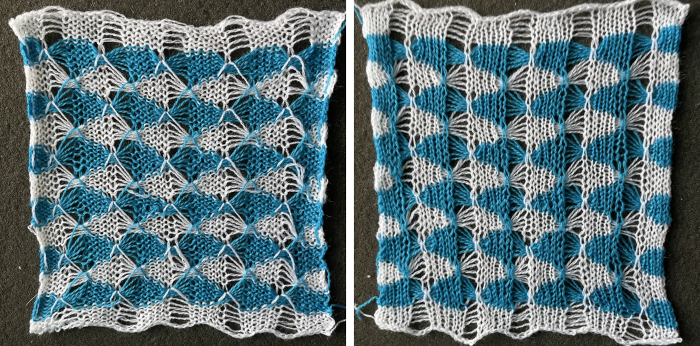 Autocams are drum pattern devices that attach in pairs to the Dubied carriage that modify the stitches much like a punchcard would. It is a drum with pegs of different sizes and positions that rotates with a pass to the opposite side. The cams are selected by fingers. The description is evocative of the Passap needle pattern selection in response to its pusher placements.
Autocams are drum pattern devices that attach in pairs to the Dubied carriage that modify the stitches much like a punchcard would. It is a drum with pegs of different sizes and positions that rotates with a pass to the opposite side. The cams are selected by fingers. The description is evocative of the Passap needle pattern selection in response to its pusher placements.
To execute this swatch, the top bed was programmed with a repeat suitable for punch card machines.
Guilloche fabrics are made with rows of stitches where tuck and knit stitches are combined and alternated for multiple fixed needle selection rows.
The working theory on converting the published instructions:  While the program eliminates having to change cam buttons manually on the top bed, the ribber settings need to be changed with each color change.
While the program eliminates having to change cam buttons manually on the top bed, the ribber settings need to be changed with each color change.
The tucks happen on both beds for 6 rows, so it is a necessity that any Brother sampling is knit using thin yarns. Here the dark is a 2/20 wool, and the light is a 2/28 unknown fiber, possibly acrylic, knit at tension 4 on both beds.
End needle selection is on, KCI.
The repeat is 12 rows in height.
Color changes and carriage settings happen every 6 rows.
The first preselection row is toward the color changer, the design will begin with a tuck pattern on the top bed and the ribber set to knit.  On completion of the first 6 rows, COL, every needle on the top bed will have been preselected to the D position, the warning that a color carriage setting changes are due before continuing to knit. The top bed remains set to tuck but will subsequently knit every needle. The ribber needs to be manually set to tuck in both directions.
On completion of the first 6 rows, COL, every needle on the top bed will have been preselected to the D position, the warning that a color carriage setting changes are due before continuing to knit. The top bed remains set to tuck but will subsequently knit every needle. The ribber needs to be manually set to tuck in both directions. 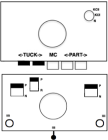 Upon completion of the 12-row repeat, with COL once more, the top bed will have been preselected in the tuck pattern, the warning that color and carriage setting changes are due before continuing to knit.
Upon completion of the 12-row repeat, with COL once more, the top bed will have been preselected in the tuck pattern, the warning that color and carriage setting changes are due before continuing to knit.
The ribber is set to knit once more, and the process is repeated.
Two views of the needle setup: 
 A small proof of concept
A small proof of concept 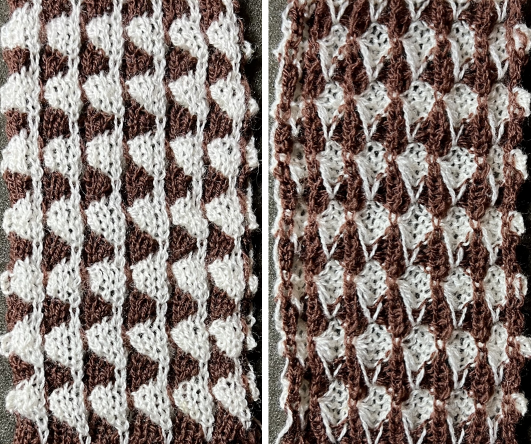 One from the Italian language supplement:
One from the Italian language supplement:  For this fabric, the ribber needles need to be manually selected for every other pair of rows. Needle selections on the top bed provide clues as to what the settings should be on the ribber as in the previous swatch.
For this fabric, the ribber needles need to be manually selected for every other pair of rows. Needle selections on the top bed provide clues as to what the settings should be on the ribber as in the previous swatch.
The top bed is programmed with a repeat suitable for punchcard machines ![]() The needle arrangement was set up as given. The end needle selection is on, set to KCI.
The needle arrangement was set up as given. The end needle selection is on, set to KCI.
The main bed remains set to tuck in both directions.
The colors and settings on the ribber are both changed after each 2-row sequence.
The ribber needles need to be manually selected with 1 needle up to the E position for knit stitches followed by 2 needles in the B position for tuck stitches, repeating across the knitting width.
The ribber settings also need to be changed and set to tuck in both directions so that the needle selection will knit on the “high” and tuck on the “low” needles as in the Dubied.
When the two ribber tuck rows have been completed, with the next color change, COL, the ribber carriage is set to knit in both directions once more and the patterning reverses beds. 
A simple plaid idea using the slip setting: the 32-row repeat shown on the far right was programmed, and color changes happen after altered preselection on the top bed.
The dominant color (white cells) knits on all needles, while the contrast (dark cells) knits on the ribber only while stitches skipped on the top bed become elongated as they are skipped. 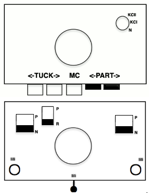
 Things to consider:
Things to consider:
A. when first changing colors, the yarn may drop the first few stitches or for other reasons even drop a whole row. If the knitting is started on waste yarn before any permanent cast-on for the piece, one can insure that color changes happen properly and asses the proper tensions for the yarn used on the specific needle arrangements.
B. the ground color in this instance is changed after 16 rows, the contrast at far shorter intervals. Lengths will form on the color changer side of each contrasting color. They can be intentionally lengthened further so that after the piece, they may, in turn, be cut, resulting in yarn ends long enough to be woven into the rib. If doing so, make certain those first few stitches after the color change form properly. There are other ways to handle yarn loops and ends like these; test any favorite on long enough swatches first.
C: all-rib areas will be slightly wider than those where only a single bed knits
D: in the areas where only a single bed knits, there will be some narrowing.  Revisiting Large eyelet lace, hand transferred (or not) 2013
Revisiting Large eyelet lace, hand transferred (or not) 2013
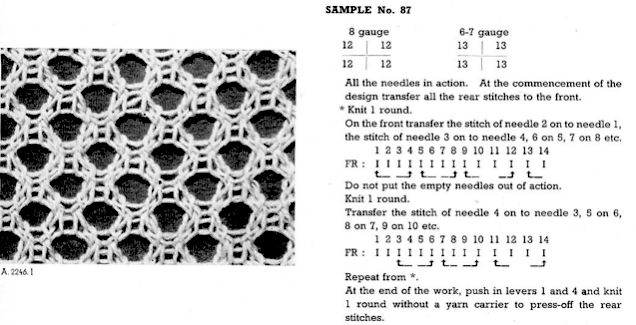 It would appear the original cast-on for this is performed on the double bed with a transfer to the front of all rear stitches.
It would appear the original cast-on for this is performed on the double bed with a transfer to the front of all rear stitches.
To duplicate in Brother, cast on every other needle, and transfer all stitches to the knit, top bed, or cast on the top bed.
The fabric benefits from the use of even weight.
This sample uses 2/8 wool, tension 8. The setup was changed slightly, resulting in empty needles at alternating side edges.
Planning out the repeats on a multiple of 4+2
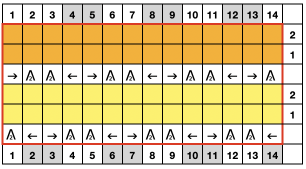 The edge stitch is moved as well. As recommended in the instructions, all empty needles are left in work position B or pushed to E before knitting the next row. Knit one round translates to knit 2 rows, which happens after each row of transfers; the carriage will move from and return to the same side.
The edge stitch is moved as well. As recommended in the instructions, all empty needles are left in work position B or pushed to E before knitting the next row. Knit one round translates to knit 2 rows, which happens after each row of transfers; the carriage will move from and return to the same side.
The swatch is shown in progress; watch for any loop formation on either side.  As with any time in knitting when there are 2 side-by-side empty needles, the loops on those needles will not form stitches, but rather, ladders with each carriage pass.
As with any time in knitting when there are 2 side-by-side empty needles, the loops on those needles will not form stitches, but rather, ladders with each carriage pass. 
 The transferred stitches have been knit for 2 rows, so the transfers are made again of single stitches onto the loops on either side of them, securing the loops before knitting continues. Here there is an empty needle on the far left,
The transferred stitches have been knit for 2 rows, so the transfers are made again of single stitches onto the loops on either side of them, securing the loops before knitting continues. Here there is an empty needle on the far left,  and here on the far right
and here on the far right  The resulting swatch, with a dropped stitch I missed on a row shortly after casting on
The resulting swatch, with a dropped stitch I missed on a row shortly after casting on 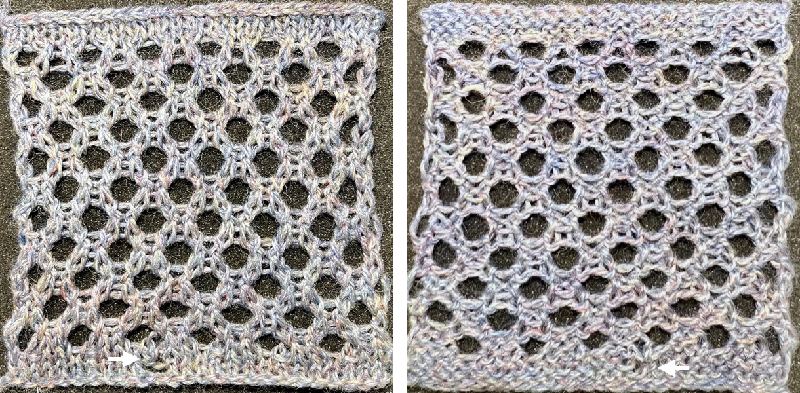 Before binding off, after a single row is knit, drop one of the double loops, insert a single eye tool back to front, turn it clockwise, and lift the result onto the now empty needle, essentially creating an e-wrap. Work across the row, knit at least 2 rows, and bind off loosely.
Before binding off, after a single row is knit, drop one of the double loops, insert a single eye tool back to front, turn it clockwise, and lift the result onto the now empty needle, essentially creating an e-wrap. Work across the row, knit at least 2 rows, and bind off loosely.
Truchet/Smith inspired designs 2 meet ArahPaint
Added explorations of the Smith tiles.
Most common knitting machines capable of accepting electronic pattern downloads have a number of needles ranging between 180 and 200 on either of the available beds.
Punchcard machines have a 24-stitch constraint in width for repeats that are selected in fixed locations on the top bed, while height row counts can be endless if one keeps joining punchcards together.
The narrow repeat width does not allow for impactful tiling such as seen in the truchet variants.
A 24-stitch initial repeat can be created, but will not align properly ie. here:
the 24X56 png, ![]() colored in and repeated in width and height X3.
colored in and repeated in width and height X3. 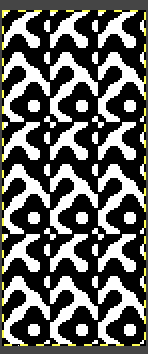 It can, however, be drawn in repeat using ArahPaint to produce a new and successful design repeat ie this 48X112 pixels version
It can, however, be drawn in repeat using ArahPaint to produce a new and successful design repeat ie this 48X112 pixels version ![]() and its appearance in repeat on a larger canvas:
and its appearance in repeat on a larger canvas:  Electronic machines can be used to knit large, non-repetitive designs based on the number of needles available on their beds.
Electronic machines can be used to knit large, non-repetitive designs based on the number of needles available on their beds.
Unless knit-from-screen software is used, the size of the files downloaded to specific machine models varies depending on both the software used and the knitting machine’s available memory.
One of the issues using online generators as seen in the previous post is that the files tend to be high in pixel counts and rendered in RGB mode.
Changing image modes to BW indexed and scaling the large design to a smaller version have an effect on the edge definition of the shapes and are likely to require clean-up to remove or add pixels.
Beginning with small and clearly defined forms, tiling repeatedly to larger ones will allow for results that can be cropped to specific sizes with clean edges along the secondary shapes.
Beginning the proposed method with the Smith tile, a place to start is to choose the smallest successful circular forms.
The repeat works using quarter squares, so the file size needs to be an even number of pixels in width and height.
Getting a sense of the appearance of the edges of small circular shapes, with the intent of choosing one for fabric development, beginning with an 8-pixel diameter, and increasing it in turn by 2 pixels at a time to 20.  The 8-pixel circle is chosen for this exercise.
The 8-pixel circle is chosen for this exercise.
Following the steps outlined by the developer in the video viewable on Instagram and Facebook, open a new picture, and set the image size to 8X8 pixels 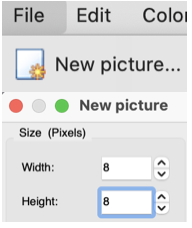 The goal is to create a clean design outline forming shapes that may be filled in to yield the secondary tiling designs.
The goal is to create a clean design outline forming shapes that may be filled in to yield the secondary tiling designs.
To zoom in or out in ArahPaint: use Shift+ or – on Mac, click on the magnifying lens icons in the toolbox,  use the command key and roll the mouse wheel or scroll along the vertical center line of the mouse, or press any number from 0-9 on the keyboard to change zoom directly to that level (1 means 100%, 6 means 600%, O means 1000%).
use the command key and roll the mouse wheel or scroll along the vertical center line of the mouse, or press any number from 0-9 on the keyboard to change zoom directly to that level (1 means 100%, 6 means 600%, O means 1000%).
In RGB mode even if the shapes are drawn in black, when converted to indexed BW some pixels will be lost. If any lines are broken, control in using the bucket fill tool on only selected areas is lost.
To begin with, set the number of colors and the pencil size to one pixel 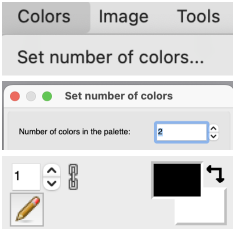 Use the draw circle tool, and select drawing from the center
Use the draw circle tool, and select drawing from the center 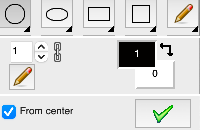 Draw a quarter circle starting on the bottom right of the square, and ending in the center of this image. In this case, there will be 4 white pixels on the left of the line, half the diameter of the planned circle. Click on the pencil tool to set the image.
Draw a quarter circle starting on the bottom right of the square, and ending in the center of this image. In this case, there will be 4 white pixels on the left of the line, half the diameter of the planned circle. Click on the pencil tool to set the image.  Repeat the Process, drawing a mirrored image beginning on the upper left pixel position, and ending in the center of the image as well
Repeat the Process, drawing a mirrored image beginning on the upper left pixel position, and ending in the center of the image as well 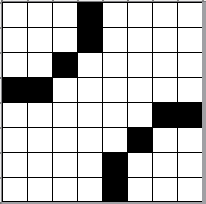 Open the drawing in the repeat window
Open the drawing in the repeat window 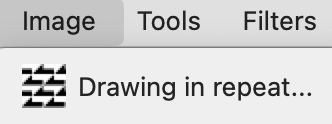 and set the number of repeats vertically and horizontally, done here first in standard alignment. Do not click on random, select new picture, OK. If satisfied, save the png.
and set the number of repeats vertically and horizontally, done here first in standard alignment. Do not click on random, select new picture, OK. If satisfied, save the png.  Undo may be used to revert to the original file unless new picture was left unchecked.
Undo may be used to revert to the original file unless new picture was left unchecked.
For the Smith tile repeat, do click on random to apply different rotations of the repeat.
Load the 8X8 file
Zoom out to check the pattern and view changes adequately
Open the draw in repeat window
Click on random, and the proposed rotations will appear as symbols,  click on new picture and then on OK to view the result, a file that will now be 32X48 pixels. The result can be saved.
click on new picture and then on OK to view the result, a file that will now be 32X48 pixels. The result can be saved. ![]() To preview other arrangements:
To preview other arrangements:
choose undo, return to draw in repeat, random, preview, and with each repeated click on random a new image will appear on the screen. ![]() At any point select a new picture, OK, and save the result.
At any point select a new picture, OK, and save the result. ![]() The final png for test knitting for my test swatch
The final png for test knitting for my test swatch ![]() Its segments bucket filled with black
Its segments bucket filled with black ![]()
 If bucket fill fails selectively and floods the whole image, return to drawing in repeat and click on close. Return to the image and continue the fill-in process.
If bucket fill fails selectively and floods the whole image, return to drawing in repeat and click on close. Return to the image and continue the fill-in process.
Developing a larger repeat to select an area of interest while keeping in mind the maximum needle width of 200. This repeat is perhaps usefully cropped to blanket size.  Seeking a shorter and narrower motif for a scarf, in the range of 60 to 100 pixels in width that may not require too many tracks when programming the 930, the same 32X48 design is drawn in repeat X4 in width, X2 in height to 128X96 pixels.
Seeking a shorter and narrower motif for a scarf, in the range of 60 to 100 pixels in width that may not require too many tracks when programming the 930, the same 32X48 design is drawn in repeat X4 in width, X2 in height to 128X96 pixels.  The above is split directly in half vertically for this exercise, rendering two files, each composed of 64X96 pixels. The left half,
The above is split directly in half vertically for this exercise, rendering two files, each composed of 64X96 pixels. The left half,  and the right
and the right  Checking vertical alignments
Checking vertical alignments  and committing to the one on the right for the test swatch, knitting on 60 stitches for 120 design rows, using KCI, and starting with dark color from left.
and committing to the one on the right for the test swatch, knitting on 60 stitches for 120 design rows, using KCI, and starting with dark color from left.  That shape in blue that looks almost rectangular is actually not quite circular in the repeat, seen here color-reversed on the bottom right, with the definition also slightly lost in the knit due to the stitch size and birdseye stitches twist.
That shape in blue that looks almost rectangular is actually not quite circular in the repeat, seen here color-reversed on the bottom right, with the definition also slightly lost in the knit due to the stitch size and birdseye stitches twist.  Comparing the 3 swatches in scale and shape definition:
Comparing the 3 swatches in scale and shape definition:  A tiny repeat formed with a thicker line
A tiny repeat formed with a thicker line 
![]() Drawn in random repeat
Drawn in random repeat 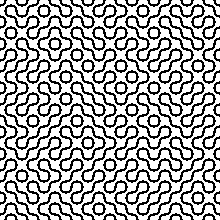 Dividing shapes into symmetrical segments is easy after configuring grid properties, in this case into thirds
Dividing shapes into symmetrical segments is easy after configuring grid properties, in this case into thirds  12X12 in repeat
12X12 in repeat  adding an outline to change the weight of the lines by a single pixel all over without using more specific options
adding an outline to change the weight of the lines by a single pixel all over without using more specific options 
 Using the filled in double circle
Using the filled in double circle  18X18 repeats
18X18 repeats ![]()
![]() drawn in repeat
drawn in repeat  While the definition of true circular shapes may be an issue for some when knitting the Smith variant, others may enjoy variations made by playing with other shapes and angles, here a 16-pixel square was divided into quarters
While the definition of true circular shapes may be an issue for some when knitting the Smith variant, others may enjoy variations made by playing with other shapes and angles, here a 16-pixel square was divided into quarters 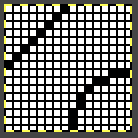
![]()
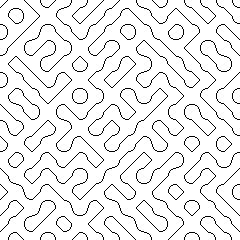 adding a single pixel contour
adding a single pixel contour  combining quarter circles sith full squares
combining quarter circles sith full squares 
![]()
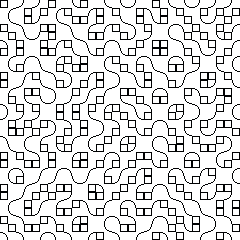 Building larger repeats with interwoven intersections
Building larger repeats with interwoven intersections ![]()
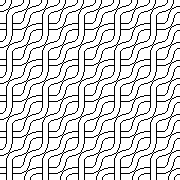
![]()

 Playing with adding colors. In many instances when tiles are drawn in repeats requiring rotations of the original file, coloring in needs to be done after the final image has been composed.
Playing with adding colors. In many instances when tiles are drawn in repeats requiring rotations of the original file, coloring in needs to be done after the final image has been composed. 

 Color exchanging fine black outlines to white, or filling the white background with black in order to reduce files for knitting no more than 3 colors per row.
Color exchanging fine black outlines to white, or filling the white background with black in order to reduce files for knitting no more than 3 colors per row.  The more complex designs become exponentially larger, require electronic downloads, and must meet the limitations of machine memory. The maximum equivalent for pixel per stitch is 200 pixels in width on 4.5 mm knitting machines, and 180 for Passap, with the possibility of separating the width and length into panels for large pieces ie tapestries, or blankets. Long vertical design segments, depending on their height, may also need to be separated in steps for programming them to produce narrow, long, pieces such as scarves or shawls.
The more complex designs become exponentially larger, require electronic downloads, and must meet the limitations of machine memory. The maximum equivalent for pixel per stitch is 200 pixels in width on 4.5 mm knitting machines, and 180 for Passap, with the possibility of separating the width and length into panels for large pieces ie tapestries, or blankets. Long vertical design segments, depending on their height, may also need to be separated in steps for programming them to produce narrow, long, pieces such as scarves or shawls.
The truchet triangles pose a different issue in knit design.
Quilters are familiar with block designs easily found in print and online that technically may be broken down into triangular blocks joined and meeting to form sharp points.  Truchet in his publication used half-square triangles
Truchet in his publication used half-square triangles  and assigned letters to the segments,
and assigned letters to the segments,  providing alphabetical references in illustrations for the permutations,
providing alphabetical references in illustrations for the permutations,  all far easier to achieve nowadays with the aid of software.
all far easier to achieve nowadays with the aid of software.
In ArahPaint, begin with choosing a square size, in this instance, 8 pixels by 8 pixels, matching that in the exercise using circles, and draw a triangle filling the canvas from corner to corner ![]() Drawing in repeat, the choice is made to repeat the triangles twice in both width and height, the preview symbols for the rotations of the shape are illustrated pointing in the same direction by default.
Drawing in repeat, the choice is made to repeat the triangles twice in both width and height, the preview symbols for the rotations of the shape are illustrated pointing in the same direction by default. 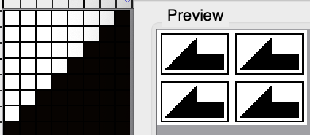 Clicking on any of those half-arrow shapes will rotate the specific shape in the tiled design, this becomes an action that may be influenced manually.
Clicking on any of those half-arrow shapes will rotate the specific shape in the tiled design, this becomes an action that may be influenced manually.  Selecting new image will render this,
Selecting new image will render this,  which illustrates what happens when those triangles are used in knit motif designs. Inevitably, there will be areas where corner pixels meet to join others and the choice will need to be made between using the original or the color-reversed version of the repeat.
which illustrates what happens when those triangles are used in knit motif designs. Inevitably, there will be areas where corner pixels meet to join others and the choice will need to be made between using the original or the color-reversed version of the repeat. ![]() Designing for a maximum 200-pixel design, the number of available needles on Japanese knitting machines, and continuing with random selections, paste 25 times in each direction, ultimately saving one of the new images:
Designing for a maximum 200-pixel design, the number of available needles on Japanese knitting machines, and continuing with random selections, paste 25 times in each direction, ultimately saving one of the new images:
 its color reversed version
its color reversed version  Deciding on the first, an isolated area can be cropped to be used in an accessory ie a 72-stitch scarf, retaining full triangles, using the full 200-pixel height.
Deciding on the first, an isolated area can be cropped to be used in an accessory ie a 72-stitch scarf, retaining full triangles, using the full 200-pixel height.  Wanting to retain a 96-row max height for use on the 930, what happens when repeats line up vertically? the isolated 72X96 design
Wanting to retain a 96-row max height for use on the 930, what happens when repeats line up vertically? the isolated 72X96 design  The assumption is that any change in vertical simple repeats will line up forming new triangles at the intersections not visually interpreted as patterning errors, the above repeated 3 times in height to 72X288
The assumption is that any change in vertical simple repeats will line up forming new triangles at the intersections not visually interpreted as patterning errors, the above repeated 3 times in height to 72X288  Committing to a test swatch: the wool ply is 2/13, and the space dyed rayon 20/2 and thinner in appearance. The contrast is not high, to begin with, and since the sample is knit as DBJ, as a result of the difference in yarn thickness the dark color bleeds through behind the lighter, reducing that contrast even further.
Committing to a test swatch: the wool ply is 2/13, and the space dyed rayon 20/2 and thinner in appearance. The contrast is not high, to begin with, and since the sample is knit as DBJ, as a result of the difference in yarn thickness the dark color bleeds through behind the lighter, reducing that contrast even further.
The places where the single pixels at the individual shape corners meet other shapes in the repeat can still be easily located.
The sample repeat size is 68X96 pixels, designed to include 2-stitch vertical borders drawn with dark pixels,  the knit carriage was set to KCII, which allows the formation of distinct single color edges
the knit carriage was set to KCII, which allows the formation of distinct single color edges 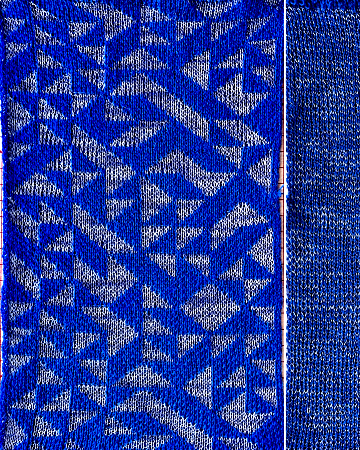 Another alternative: beginning with a 9X9 repeat,
Another alternative: beginning with a 9X9 repeat,  drawn in repeat to 225X225, shapes do not touch in this rendering,
drawn in repeat to 225X225, shapes do not touch in this rendering,  but do if color-inverted.
but do if color-inverted.  Isolating a repeat from the “floating” triangles, 45X81
Isolating a repeat from the “floating” triangles, 45X81 ![]() tiled X3 to 45X243 may look ok
tiled X3 to 45X243 may look ok ![]() but aside from the issue of choosing visually floating shapes vs still touching ones,
but aside from the issue of choosing visually floating shapes vs still touching ones, 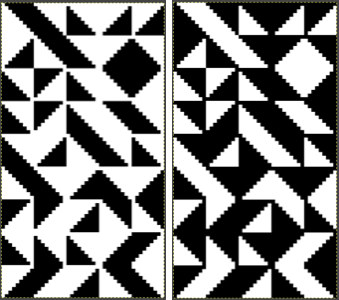 the big problem to be considered is the fact that for the machine KRC color separation to happen correctly, the repeat downloaded must be an even number of rows. A workaround may be to double the original height to 162 rows prior to programming it since one cannot use double height and KRC buttons at the same time in many machine models. Pursuing personal preferences can be endless. I am increasingly fond of the repeat that began with the 8X8 square.
the big problem to be considered is the fact that for the machine KRC color separation to happen correctly, the repeat downloaded must be an even number of rows. A workaround may be to double the original height to 162 rows prior to programming it since one cannot use double height and KRC buttons at the same time in many machine models. Pursuing personal preferences can be endless. I am increasingly fond of the repeat that began with the 8X8 square.
Working with quarter-filled segments: multiplied by 20 in each direction to a 200-pixel repeat. 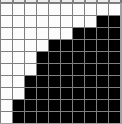
![]() Drawn using random/ preview/ prior to saving the file
Drawn using random/ preview/ prior to saving the file 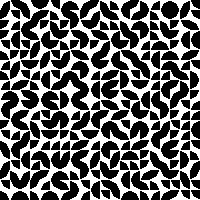 Its color reversed view
Its color reversed view 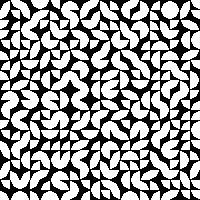
Truchet tiling design inspiration 1
For many years my knitting of accessories and wearable pieces was my source of income, guided by what pricing the local market would bear, the limitations of mylar sheets or that of an early Passap interface to program repeats, and the amount of time required to complete each piece.
There is practicality and ease in playing with colors using small motifs single-bed, and varying materials and yarn plies allowed me to aim for limited edition designs without looking at identical finished products more than once or occasionally a few times.
At first, Ayab and then img2track changed the playing field in terms of downloading and programming designs.
Eventually, my knitting moved from production pieces for sale to creating samples for my blog almost exclusively.
I have had a long and continued interest in math-based designs, and knit a line of accessories using automata-inspired repeats, often limiting the repeats in size to ones that would align vertically without having to program multiple DBJ segments, reducing the possibility of programming errors in scarves that would often require around 1200 knit rows in length.
A 930 followed the 910, this, knit in July 2021, was my first try at using img2track to download multiple tracks.  There are many ways to yield math-based patterns, and nowadays online generators and reference sites abound, making it possible for nongeeks to use the resulting files to create knit suitable designs.
There are many ways to yield math-based patterns, and nowadays online generators and reference sites abound, making it possible for nongeeks to use the resulting files to create knit suitable designs.
Some recent Truchet tile images shared on Instagram brought me back to exploring math-based images and what by default needs to be executed as larger-scale design motifs in knitting.
Sebastian Truchet was a Carmelite priest whose “Memoir sur les Combinasions” was published in 1704. It is a wealth of patterns built up from a simple motif, which you can see here
http://gallica.bnf.fr/ark:/12148/bpt6k3486m.image.f526.langFR and in which he discussed squares, half black, half white, split into triangles, with four possible orientations for each tile. He was also the inventor of the point system for indicating the sizes of typeface fonts.
His method of tiling by the combination of manipulating four-letter codes, A, B, C, and D, in rotations using triangular shapes inspired new variations in tilings.
Cyril Stanley Smith introduced two alternatives to the basic Truchet tile in 1987. One uses only diagonal lines to create maze-like designs where the coloring is removed and only the boundaries remain. The other, resulting in the designs produced in this post, uses quarter circles that may be filled or used as outlines and rotated to form the final shapes. ![]()

 Distinctions in naming the tiles are not often made. “Truchet” is the commonly used generic term.
Distinctions in naming the tiles are not often made. “Truchet” is the commonly used generic term.
Some articles on the tilings:
Generalizations of truchet tiles, Multiscale Truchet Patterns, The Tiling Patterns of Sebastien Truchet and the Topology of Structural Hierarchy, and More on tiles, fun with portraits.
Basic elements include contrasting triangles, quarter circles, and diagonal lines.
One may find code for programming DIY in various GitHub links. Python is far beyond my interest or skill, there are many ways to achieve the designs.
Spreadsheets are also programmable, but require the development of formulas.
Developing patterns from online sources, beginning with the Smith variation using quarter circles: the Wolfram site is a computing and math one well worth exploring, the files there are Computable Document Files, a document standard developed by Wolfram Research. They can be saved and opened using the Wolfram CDF Player, which is a standalone application and a Web browser plug-in provided for free.
To preview search results in a browser: https://demonstrations.wolfram.com/TruchetTiles/.
Ad blockers may interfere with proper previews in Safari but appears to not be an issue using Chrome as the browser.
Files cannot be saved from the preview results other than as screengrabs.
What is cdf
For permanent access to preferred CDFs:
CDF Wolfram player download is available for Mac and Windows, you will be asked to provide an email address.
After the player is installed and opened, click on the central option, 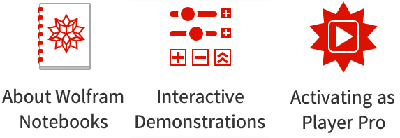 and search for your area of interest.
and search for your area of interest.  Any demonstration may be saved for future use, most are customizable to varying degrees.
Any demonstration may be saved for future use, most are customizable to varying degrees.
In my first effort, I used colors and left the black outlines. The second, simpler method of editing follows below it.  The swatch png, 58X150, includes 2 stitch vertical borders in the dark color. The machine was set to the built-in KRC color separation for DBJ. Some of the circular shapes have been already edited, but if I were to reuse the repeat, I would clean up more of the design shape edges
The swatch png, 58X150, includes 2 stitch vertical borders in the dark color. The machine was set to the built-in KRC color separation for DBJ. Some of the circular shapes have been already edited, but if I were to reuse the repeat, I would clean up more of the design shape edges
160 design rows were knit, measuring 7.5 inches by 20.5.
The dark color is a chenille from an unmarked cone with uncertain yardage. The space-dyed is an 8/2 rayon slub.
Tension was set at 5/5, the knit carriage on KCI, and the ribber using lili buttons for birdseye backing. KCII may be used as well if preferred, the side vertical edges will have a slightly different appearance. 
 Developing an added repeat:
Developing an added repeat:
the working file in the cdf is a default 600 by 600 pixels. If the goal is to save a black-and-white downloadable png, the present plan is to fill in portions of the design with black while leaving others in white.
Checking tiling insures continuous designs at any point in the process.
It is possible to directly scale size in the cdf, but the shape outlines become broken in the automatic % reduction, so the filling-in process I suggest fails to be contained. 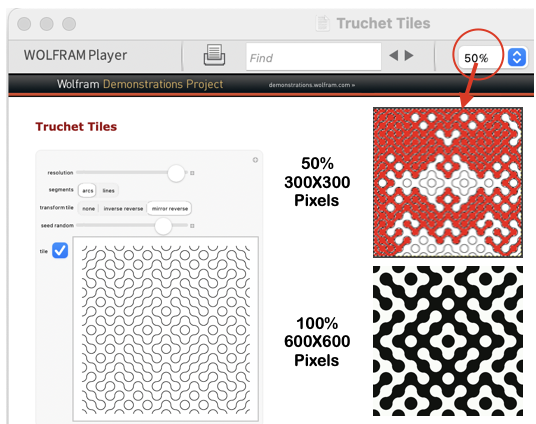 In this exercise, none of the other available parameters were changed. When the player is launched, click on the tile, it will be surrounded by an orange line,
In this exercise, none of the other available parameters were changed. When the player is launched, click on the tile, it will be surrounded by an orange line,  copy the image, and it can then be pasted directly into Gimp.
copy the image, and it can then be pasted directly into Gimp. 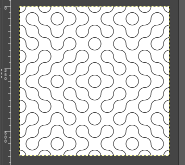 Change the Image Mode to BW Indexed before proceeding further.
Change the Image Mode to BW Indexed before proceeding further.
Using the fuzzy select tool  click on any area in the design, it will be surrounded by dotted lines
click on any area in the design, it will be surrounded by dotted lines  select bucket fill, to fill the selected area with black.
select bucket fill, to fill the selected area with black.
Edit, undo will revert to the previous steps in sequence at any point.
If satisfied, select the rectangle tool.
Clicking on the selected area 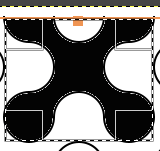 will allow its use for copying and pasting the outlined segment on a new canvas or cropping the area to the selection for saving while clicking anywhere in the Gimp work window fixes the results. The dotted lines disappear. Repeat the process on the remaining image.
will allow its use for copying and pasting the outlined segment on a new canvas or cropping the area to the selection for saving while clicking anywhere in the Gimp work window fixes the results. The dotted lines disappear. Repeat the process on the remaining image.  The processed file will measure 600X600 pixels.
The processed file will measure 600X600 pixels.
Anyone working with large-scale images and reducing file size to make them available for knitting as single panels on a standard machine is familiar with the loss of detail and the need for cleanup of edges as incremental decreases in file size are attempted.
Magnifying any of these will help evaluate forms and scaling decisions for final repeats to be used in knit test swatches.
Downloading or copying and pasting them from here for personal use may change the image mode to RGB in the process, check mode and convert them to indexed BW if needed before any further use.
300X300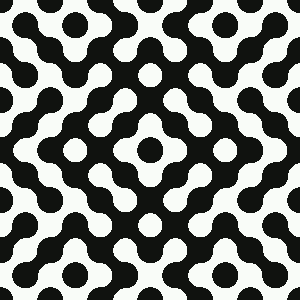 200X200 pixels
200X200 pixels  150X150 pixels
150X150 pixels 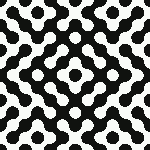
 The proof of concept was knit using the 100X200 repeat without any pixel cleanup.
The proof of concept was knit using the 100X200 repeat without any pixel cleanup. 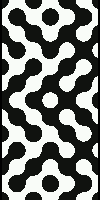 The blue yarn is a 2/20 wool, and the white is a 2/28 Italian yarn of unspecified fiber content from my stash. Both beds were set at 2/2. The KRC setting separated the colors so each color in each row knits only once, but it takes 2 passes to complete one row, so 100 design rows translate to 200 rows of knitting. In this instance, img2track used on the 930 broke up the design into 2 tracks, a 66-row first track, followed by a 134-row one.
The blue yarn is a 2/20 wool, and the white is a 2/28 Italian yarn of unspecified fiber content from my stash. Both beds were set at 2/2. The KRC setting separated the colors so each color in each row knits only once, but it takes 2 passes to complete one row, so 100 design rows translate to 200 rows of knitting. In this instance, img2track used on the 930 broke up the design into 2 tracks, a 66-row first track, followed by a 134-row one.
Each track needed to be programmed sequentially.
The ribber was set for birdseye backing, which in this case results in an interesting shadowing of the pattern 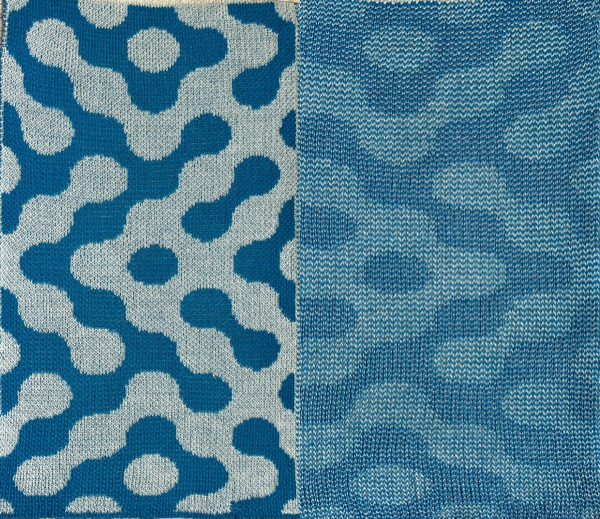 Comparing the two swatches:
Comparing the two swatches:  Variations in tiles made by changing variable view options
Variations in tiles made by changing variable view options  will still align when combined, easily producing a range of new designs at merging points. Use guides to help narrow down segments of interest, here they are placed at even 100-pixel intervals on two adjoining 600-pixel images.
will still align when combined, easily producing a range of new designs at merging points. Use guides to help narrow down segments of interest, here they are placed at even 100-pixel intervals on two adjoining 600-pixel images. 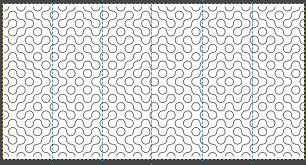 To remove a single guide after placing it, go to Edit, Undo Add the Horizontal or Vertical Guide. To remove all guides, go to View, and uncheck Show Guides.
To remove a single guide after placing it, go to Edit, Undo Add the Horizontal or Vertical Guide. To remove all guides, go to View, and uncheck Show Guides.
And for those not averse to developing any larger motifs from scratch, the limitations of any geometric shape, when reduced to low-resolution knitting, mean the search must begin for what one determines to be a pleasing circular form.  My original circle was placed on a 40X40 grid with outlines every 10 cells, the central circular 20X20 repeat was isolated and split into quarters, in turn generating these 2 tiles out of the 8 total required, also 20X20, with the second the color-reversed image of the first.
My original circle was placed on a 40X40 grid with outlines every 10 cells, the central circular 20X20 repeat was isolated and split into quarters, in turn generating these 2 tiles out of the 8 total required, also 20X20, with the second the color-reversed image of the first. ![]()
![]() A similar approach can be used in color to visualize the initial 8 tile repeats and their rotations in order to form new shapes. This technique may be useful in planning floor tile patterns but is cumbersome for developing knit designs.
A similar approach can be used in color to visualize the initial 8 tile repeats and their rotations in order to form new shapes. This technique may be useful in planning floor tile patterns but is cumbersome for developing knit designs. 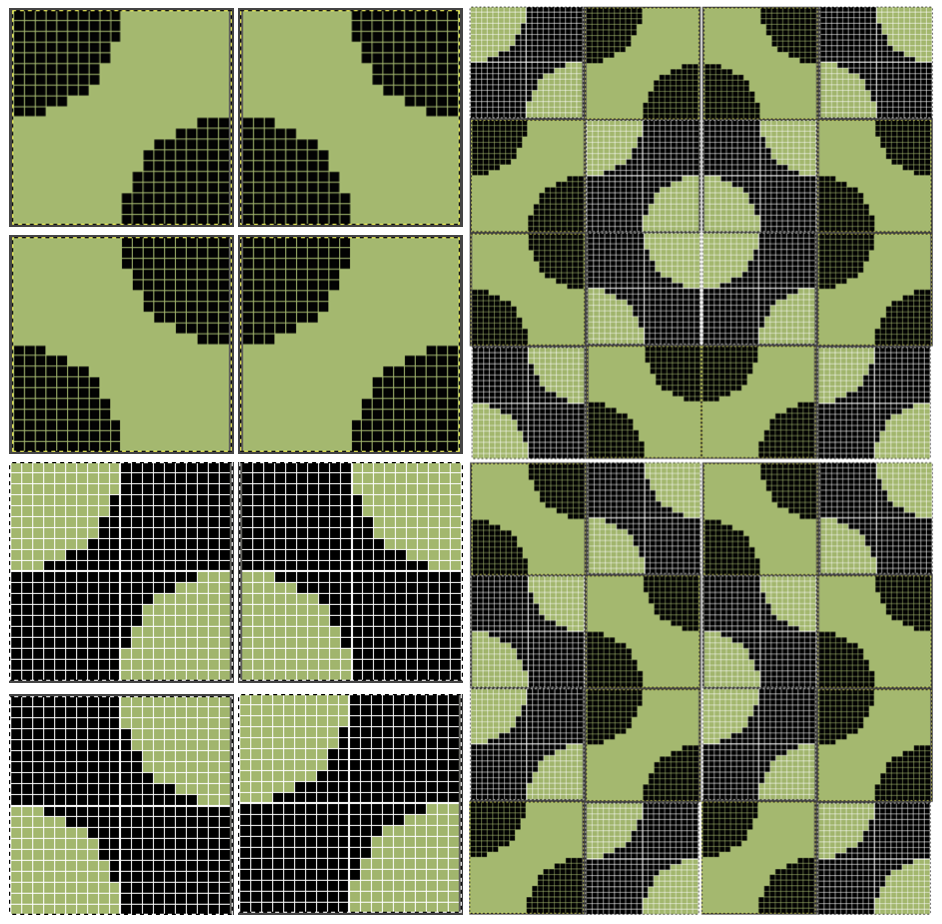 Facilitating and speeding up the process: in my post on using ArahPaint and Gimp in knit design, I briefly touched on the Drawing-in-repeat feature in Arah to produce random tiling.
Facilitating and speeding up the process: in my post on using ArahPaint and Gimp in knit design, I briefly touched on the Drawing-in-repeat feature in Arah to produce random tiling.
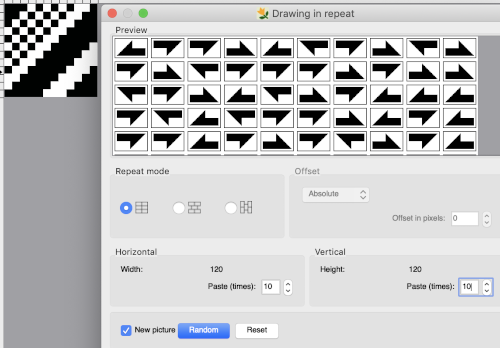 Thanks to the developer there now is a video, viewable on Instagram and Facebook, on how to use the feature for this type of tile, which allows for very quick DIY versions that can be trimmed as needed for knitting. This is my very first try, a how-to will follow in the next post.
Thanks to the developer there now is a video, viewable on Instagram and Facebook, on how to use the feature for this type of tile, which allows for very quick DIY versions that can be trimmed as needed for knitting. This is my very first try, a how-to will follow in the next post. 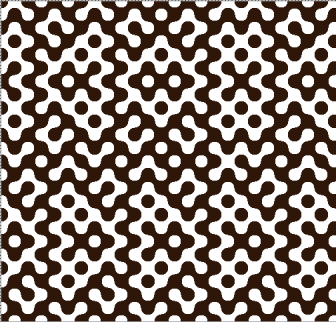 And the second, composed of triangular forms
And the second, composed of triangular forms For spreadsheet users, this one generates the various tiles in Google Sheets and a related article.
For spreadsheet users, this one generates the various tiles in Google Sheets and a related article.